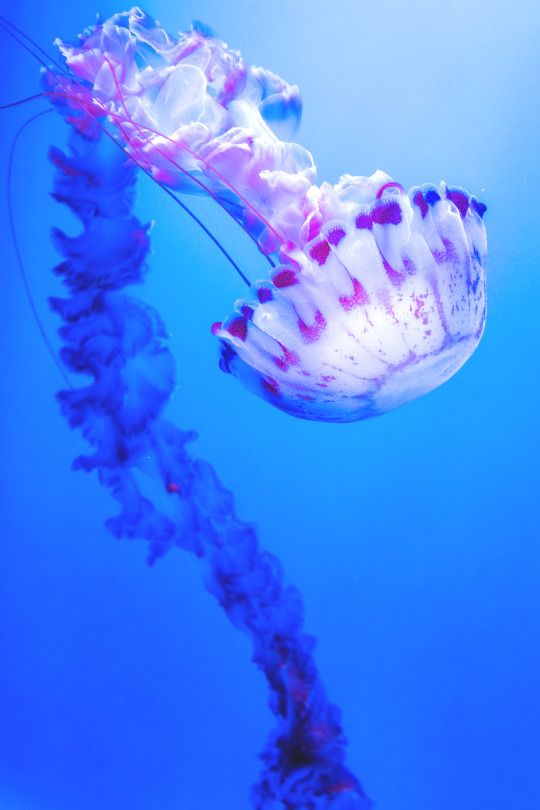Jellyfish and fish
SCDNR - Jelly fish
Jellyfish Information
- Food
- Glossary
- Life Cycles
- Local Jellyfish
- Locomotion
- Prevention
- Treatment of Sting
- Saltwater Fishing Conservation & Ethics
- Venom Apparatus
Few marine creatures are as mysterious and intimidating as jellyfish. Though easily recognized, these animals are often misunderstood and feared by beach goers, even though most jellyfish in South Carolina waters are harmless. This publication will help coastal residents and vacationers learn which jellyfish to avoid, and the ones you can safely ignore.
Jellyfish belong to a large group of marine animals that include attaching organisms such as sea anemones, sea whips, corals and hydroids that grow attached to rocks or other hard surfaces. Jellyfish and their relatives such as the Portuguese man-of-war are mobile, either actively swimming or pushed by winds and currents.
Both stationary and mobile members of this group have radial symmetry with body parts radiating from a central axis. This allows jellyfish to detect and respond to food or danger from any direction.
Jellyfish have an outer layer which covers the external body surface, and an inner layer which lines the gut. In between is a layer of thick elastic jellylike substance called mesoglea or middle jelly.
Jellyfish have a simple digestive cavity with four to eight oral arms near the mouth. These arms transport food captured by the tentacles into the mouth.
Lacking a brain, jellyfish instead have a elementary nerve net capable of detecting light, odor and other stimuli and coordinating the animal’s responses.
Jellyfish exist in many sizes, shapes and colors. Most are somewhat transparent or glassy, with a bell shape. The bell may be less than an inch across or more than a foot across. A few species reach seven feet in diameter. The tentacles of some jellyfish grow to more than 100 feet long.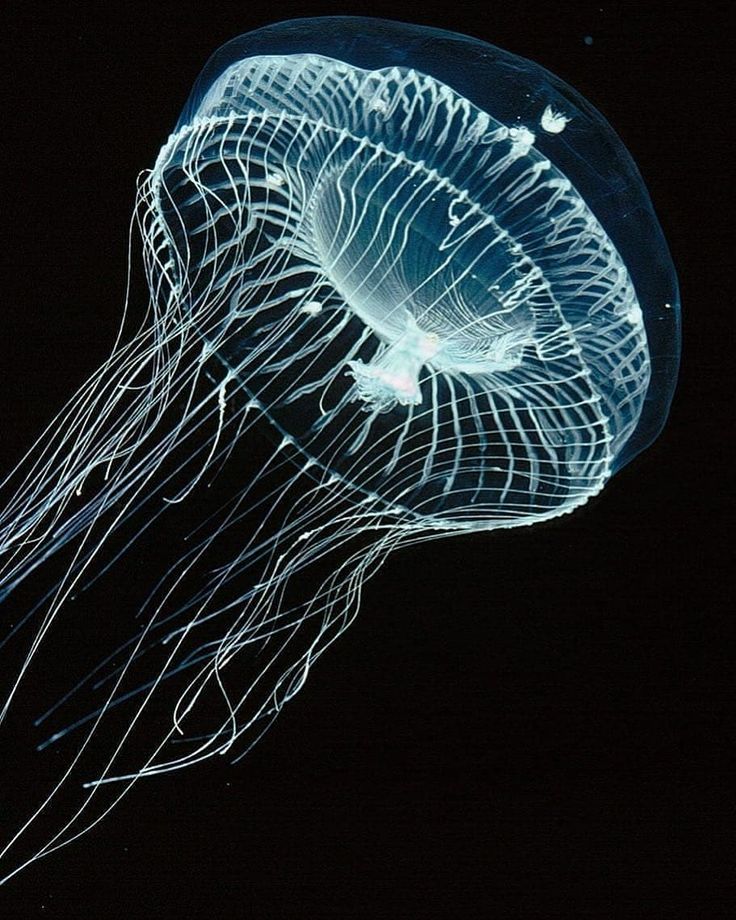 Regardless of their size or shape, most jellyfish are very fragile, consisting mostly of water.
Regardless of their size or shape, most jellyfish are very fragile, consisting mostly of water.
Jellyfish inhabit all the world's oceans and can withstand a wide range of temperatures and salinities. Most live in shallow coastal waters, but a few inhabit depths of 12,000 feet.
Life Cycles
Jellyfish have alternate generations in which the animal passes through two different body forms. They begin life as small polyps attached to solid surfaces such as rocks or shells. Using their tentacles, polyps feed on microscopic organisms in the water. Polyps can multiply by producing buds or cysts that separate from the first polyp and develop into new polyps.
When fully developed, polyps constrict in their bodies, eventually producing larvae which resemble a stack of saucers. Each individual saucer develops into a tiny jellyfish which separates itself from the stack and becomes free swimming. In a few weeks, they grow into an adult jellyfish, called a medusa.
The dominant and conspicuous medusa are either male or female.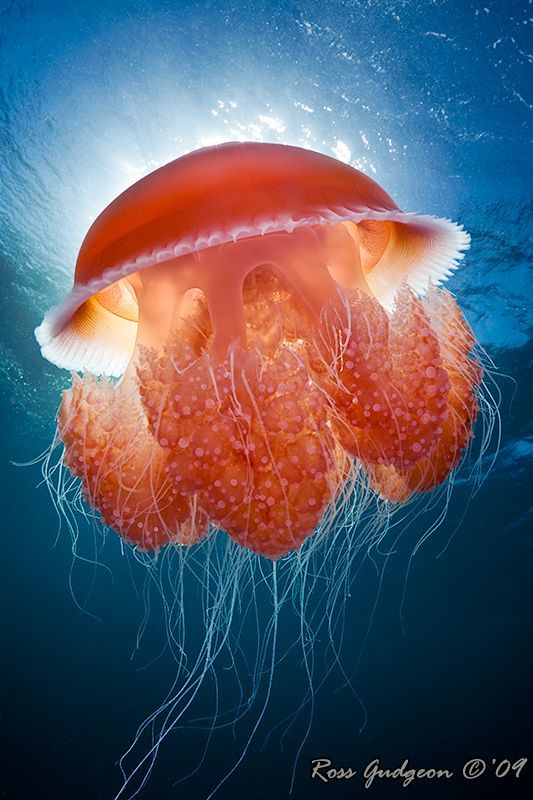 The reproductive organs (gonads) develop in the lining of the gut. During reproduction the male releases sperm into the water and the swimming sperm are swept into the female. Embryos develop either inside the female or in brood pouches along the oral arms.
The reproductive organs (gonads) develop in the lining of the gut. During reproduction the male releases sperm into the water and the swimming sperm are swept into the female. Embryos develop either inside the female or in brood pouches along the oral arms.
Eventually, small swimming larvae leave the female and enter the water column. After several days they attach themselves to something firm on the sea floor gradually transforming into flower like polyps to start the life cycle over again. Jellyfish medusae normally live for a few months; however, the polyp stage may survive for years.
Locomotion
Adult jellyfish drift in the water with limited control over horizontal movement. However, muscles that contract the bell, reducing the space under it, force water out through the opening with pulsating rhythm that creates vertical movement.
Some jellyfish, such as the sea wasp, descend to deeper waters during the bright sun of the midday and surface during early morning, late afternoon and evening.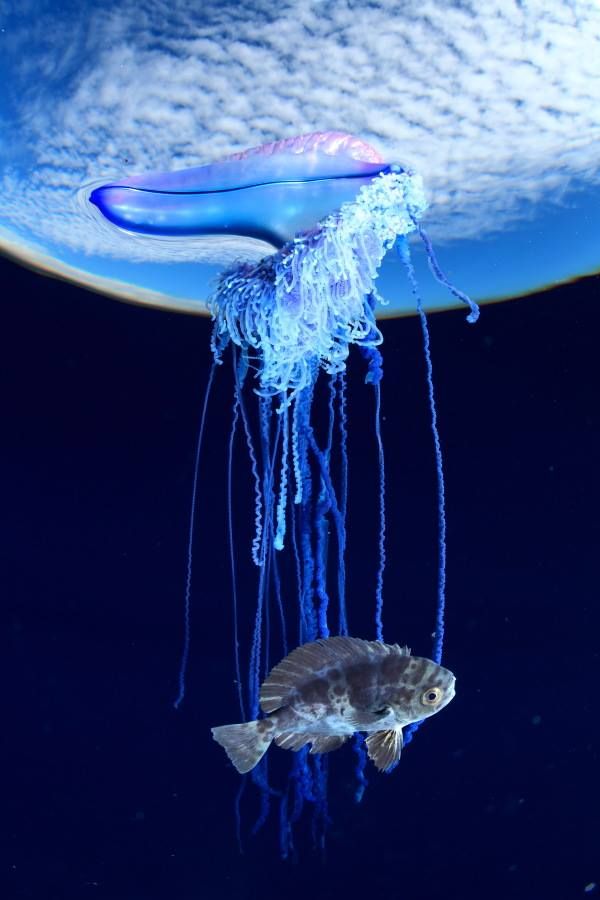 For horizontal movement from place to place however, jellyfish largely depend upon ocean currents, tides and wind.
For horizontal movement from place to place however, jellyfish largely depend upon ocean currents, tides and wind.
Food
Jellyfish form an important part of the marine food web. Carnivorous, they feed on a variety of small floating organisms as well as comb jellies and occasionally other jellyfish. Larger jellyfish can capture and devour large crustaceans and other marine organisms.
In turn, many marine animals, including spadefish, sunfish, and sea turtles eat jellyfish. Some species, including the mushroom and cannonball jellyfish, are considered a delicacy by humans. Pickled or semi-dried mushroom jellyfish are consumed in large quantities in Asia, where they constitute a multimillion-dollar part of the seafood business.
Venom Apparatus
For defense and feeding jellyfish have specialized stinging cells which contain venom. The stinging structure consists of a hollow coiled thread with barbs along its length. These nematocysts are concentrated on the tentacles or oral arms.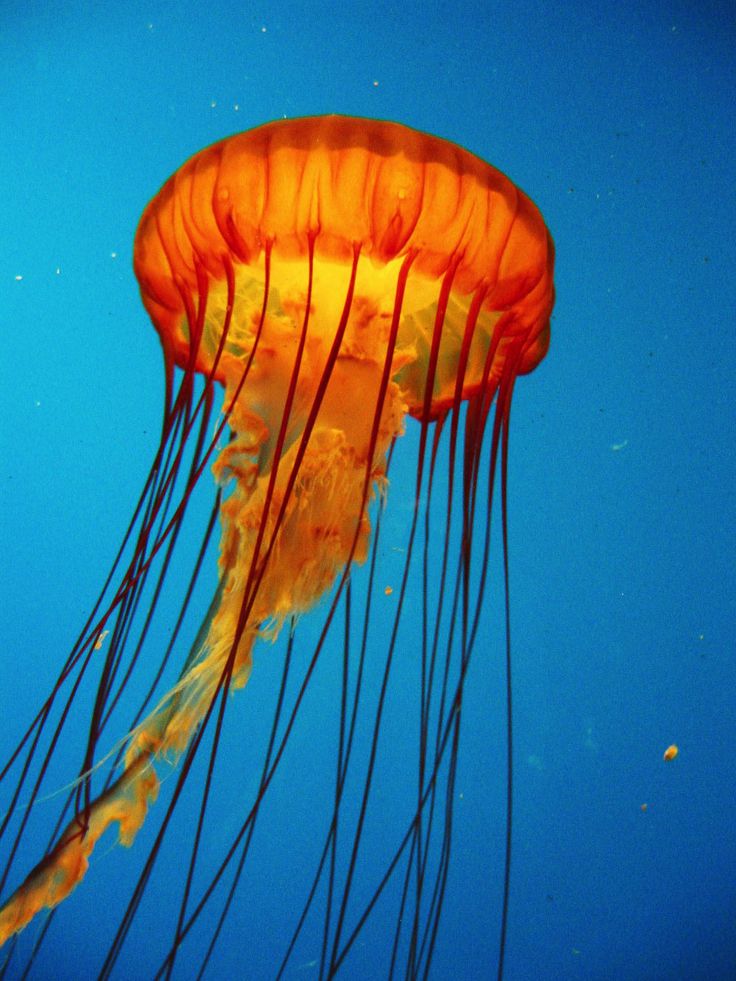 A single tentacle can have hundreds or thousands of nematocysts embedded in the epidermis.
A single tentacle can have hundreds or thousands of nematocysts embedded in the epidermis.
When tentacles make contact with an object, pressure within the nematocyst forces the stinging thread to rapidly uncoil. The thousands of nematocysts act as small harpoons, firing into prey and injecting paralyzing toxins.
Jellyfish use stings to paralyze or kill small fish and crustaceans, but the stings of some jellyfish can harm humans. Jellyfish do not “attack” humans, but swimmers and beachcombers can be stung when they accidentally touch jellyfish tentacles.
The severity of the sting depends on the species of jellyfish, the penetrating power of the nematocyst, the thickness of the victim’s skin, the sensitivity of the victim to the venom. The majority of stings from jellyfish occur in tropical and warm waters. Most jellyfish along the South Carolina coast inflict only mild stings that result in minor discomfort.
Local Jellyfish
Although most jellyfish that inhabit South Carolina waters are harmless to humans, there are a few that require caution.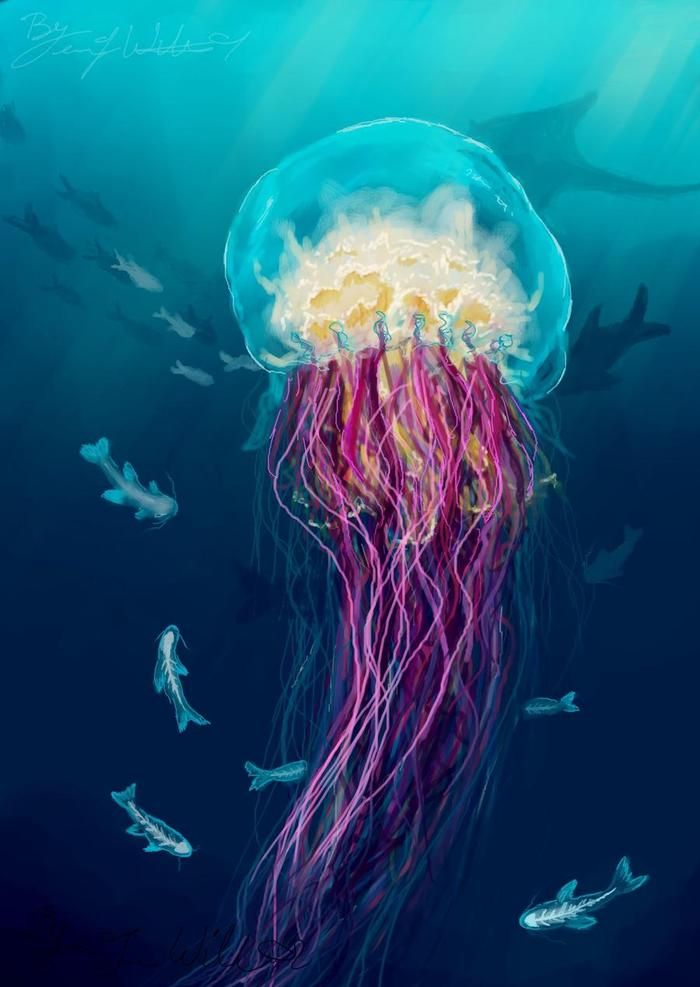 Learning how to identify the different species can help you decide which ones can be safely ignored.
Learning how to identify the different species can help you decide which ones can be safely ignored.
Cannonball Jelly
(Stomolophus meleagris)
Cannonball jellyfish are the most common jellyfish in our area, and fortunately, one of the least venomous. During the summer and fall, large numbers of this species appear near the coast and in the mouths of estuaries. Cannonball jellies have round white bells bordered below by a brown or purple band. They have no tentacles, but they do have a firm, chunky feeding apparatus formed by the joining of the oral arms.
Cannonballs rarely grow larger than 8-10 inches in diameter. Commercial trawl fishermen consider them pests because they clog and damage nets, and slow down fishing.
Lion’s Mane
(Cyanea capillata)
Also known as the winter jelly, the lion’s mane typically appears during colder months. The bell, measuring 6-8 inches, is saucer-shaped with reddish-brown oral arms and eight clusters of tentacles hanging underneath. Stinging symptoms are similar to those of the moon jelly but, usually more intense. Pain is relatively mild and often described as burning rather than stinging.
Stinging symptoms are similar to those of the moon jelly but, usually more intense. Pain is relatively mild and often described as burning rather than stinging.
Mushroom Jelly
(Rhopilema verrilli)
The mushroom jelly resembles the cannonball jelly, but differs in many ways. The larger mushroom jelly, growing 10-20 inches in diameter, lacks the brown band of the cannonball and is much flatter and softer. Like the cannonball, the mushroom jelly has no tentacles and a chunky feeding apparatus, but differs in its long fingerlike appendages that hang from the feeding apparatus.
This species is also considered a pest by commercial fishermen, but they are much less of a problem than cannonball jellies. The mushroom jelly does not represent a hazard to humans.
Southern Moon Jelly
(Aurelia marginalis)
Probably the most widely recognized jellyfish, the moon jelly occurs infrequently in South Carolina waters.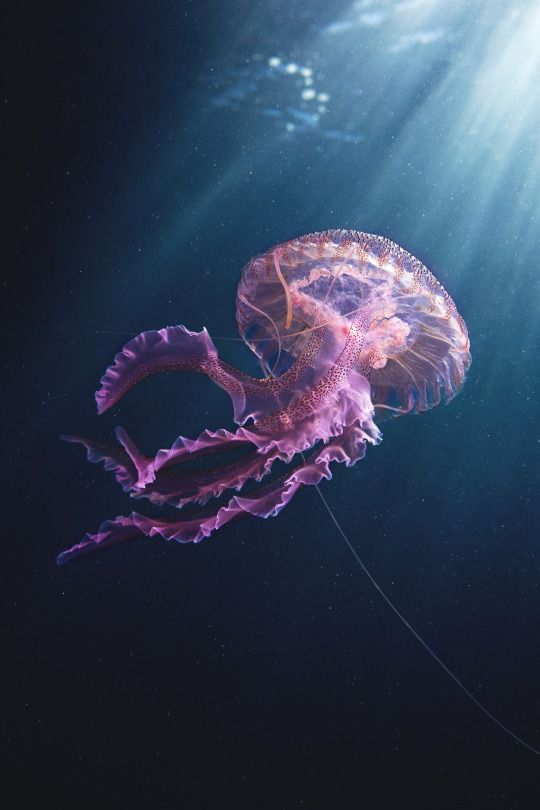 It has a transparent, saucer-shaped bell and is easily identified by the four pink “horseshoes” visible through the bell. It typically reaches 6-8 inches in diameter, but some exceed 20 inches.
It has a transparent, saucer-shaped bell and is easily identified by the four pink “horseshoes” visible through the bell. It typically reaches 6-8 inches in diameter, but some exceed 20 inches.
The moon jelly is only slightly venomous. Contact can produce prickly sensations to mild burning. Pain is usually restricted to immediate area of contact.
Sea Nettle
(Chrysaora quinquecirrha)
Common in the summer, this jellyfish is saucer-shaped, usually brown or red, and 6-8 inches in diameter. Four oral arms and long marginal tentacles hang from the bell and can extend several feet.
Considered moderate to severe, sea nettle stings are similar to those of the lion’s mane. This species causes most of the jellyfish stings that occur in South Carolina waters. Exercise caution if sea nettles are observed in the water, and do not swim if large numbers are present.
Sea Wasp
(Chiropsalmus quadrumanus)
Known as the box jelly because of its cube-shaped bell, the sea wasp is the most venomous jellyfish inhabiting our waters.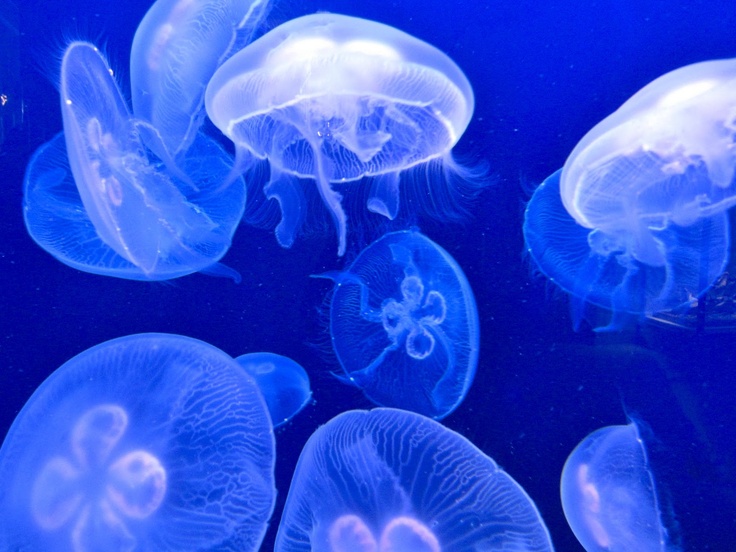 Their potent sting can cause severe skin irritation and may require hospitalization. Sea wasps are strong, graceful swimmers reaching 5-6 inches in diameter and 4-6 inches in height. Several long tentacles hang from the four corners of the cube. A similar species, the four-tentacled Tamoya haplonema, also occurs in our waters.
Their potent sting can cause severe skin irritation and may require hospitalization. Sea wasps are strong, graceful swimmers reaching 5-6 inches in diameter and 4-6 inches in height. Several long tentacles hang from the four corners of the cube. A similar species, the four-tentacled Tamoya haplonema, also occurs in our waters.
Portuguese Man-of-War
(Physalia physalis)
Although closely related to jellyfish, the Portuguese man-ofwar is not a “true” jellyfish. These animals consist of a complex colony of individual members, including a float, modified feeding polyps and reproductive medusae.
They typically inhabit the tropics, subtropics and Gulf Stream. Propelled by wind and ocean currents, they sometimes drift into nearshore waters of South Carolina. Though they visit our coast only infrequently, swimmers should learn to identify these highly venomous creatures.
The gas-filled float of the man-of-war is purple-blue, up to 10 inches long.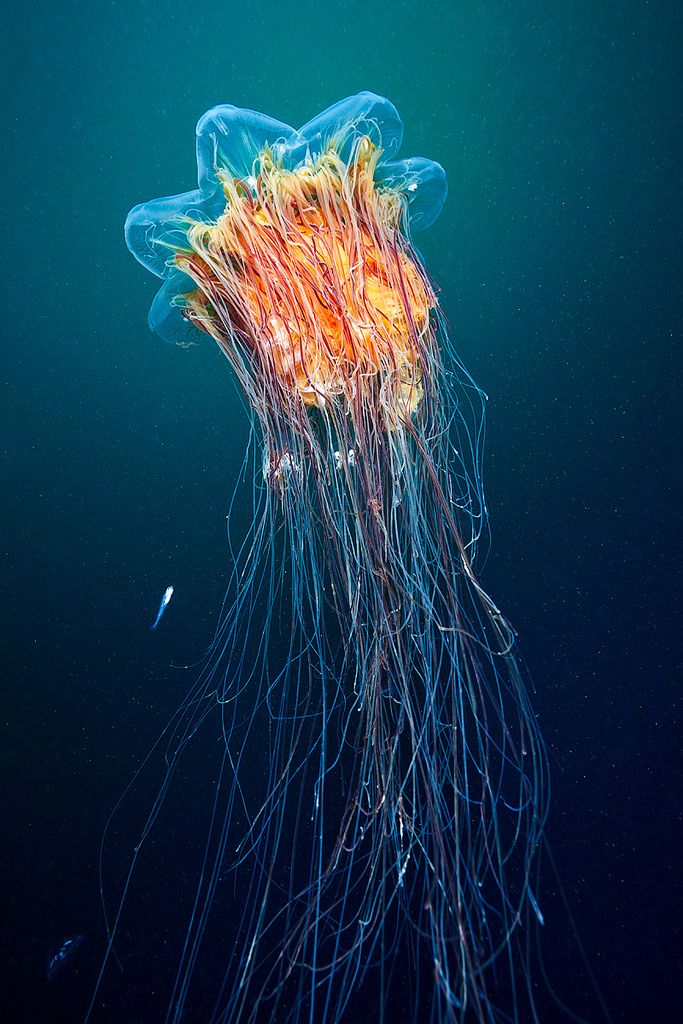 Under the float, tentacles equipped with thousands of stinging cells hang from the feeding polyps which extend as much as 30 to 60 feet.
Under the float, tentacles equipped with thousands of stinging cells hang from the feeding polyps which extend as much as 30 to 60 feet.
The man-of-war can inflict extremely painful stings. Symptoms include severe shooting pain described as a shock-like sensation, and intense joint and muscle pain. Pain may be accompanied by headaches, shock, collapse, faintness, hysteria, chills, fever, nausea and vomiting.
Initial contact with a man-of-war may produce only a small number of stings. But trying to escape from the tentacles may greatly increase stings. Severe stings can occur even when the animal is beached or dead.
Another jellyfish, the smaller by-the-wind-sailor, also has a blue bladder and occasionally enters South Carolina coastal waters, but causes only a mild, tingling sting. Given the significant danger of the man-of-war, all jellyfish having a blue float should be considered dangerous.
Treatment of Sting
If stung by a jellyfish, the victim should carefully remove the tentacles that adhere to the skin by using sand, clothing, towels, seaweed or other available materials.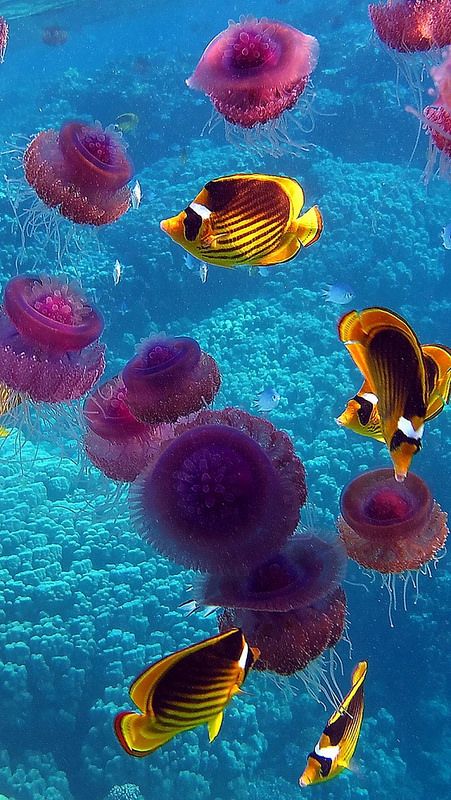 As long as tentacles remain on the skin, they will continue to discharge venom.
As long as tentacles remain on the skin, they will continue to discharge venom.
A variety of substances may reduce the effects of jellyfish stings. Meat tenderizer, sugar, vinegar, plant juices and sodium bicarbonate have all been used with varying degrees of success. Applying any form of alcohol, or urine may increase the pain and cause severe skin reactions.
Victims of serious stings should get out of the water as soon as possible to avoid drowning. If swelling and pain from more serious stings persist, prompt medical attention should be sought. Recovery periods can vary from several minutes to several weeks.
Prevention
Care should be taken when swimming in areas where dangerous jellies are known to exist or when an abundance of jellies of any type is present. Keep in mind that tentacles of some species may trail a great distance from the body of the organism and should be given lots of room. Stings, resulting from remnants of damaged tentacles, can occur in waters after heavy storms.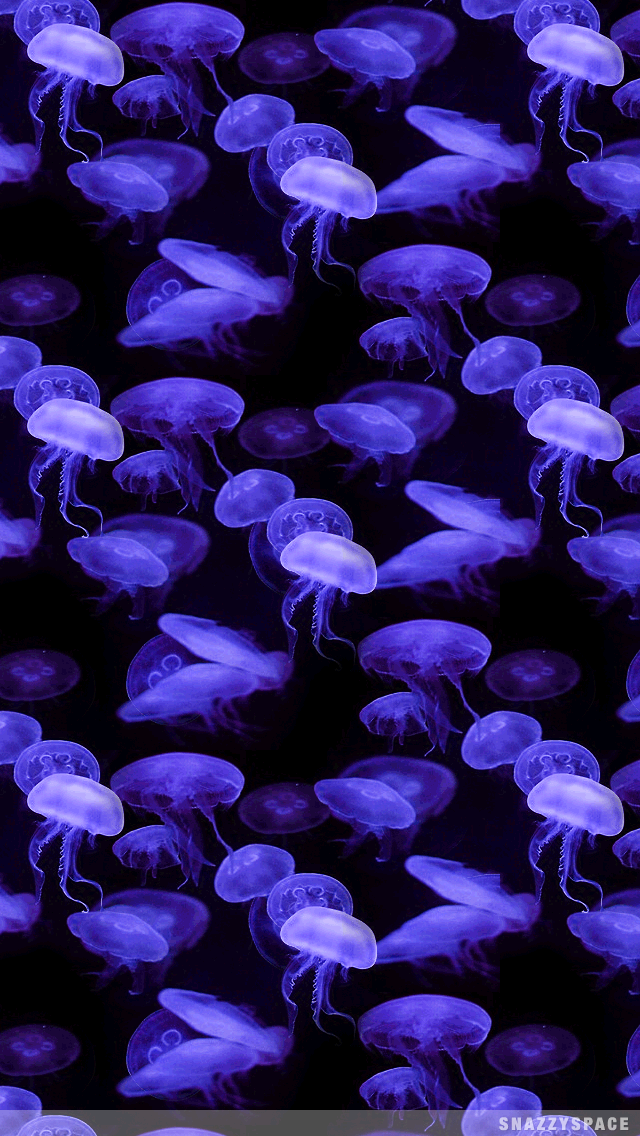 Rubber skin-diving suits offer protection against most contact.
Rubber skin-diving suits offer protection against most contact.
Be careful when investigating jellyfish that have washed ashore. Although they may be dead, they may still be capable of inflicting stings. Remember to take precautions when removing tentacles after contact or additional stings may result.
Saltwater Fishing Conservation & Ethics
Ocean resources, once thought to be unlimited, have declined rapidly in recent decades, due in part to the overharvest of many commercial and recreational species of fish and shellfish.
To reduce overfishing, all anglers should practice wise conservation practices and adopt an ethical approach to fishing.
Size and catch limits, seasons and gear restrictions should be adhered to strictly. These regulations change from time to time as managers learn more about fish life histories and how to provide angling opportunities without depleting fish populations.
The challenge of catching, not killing, fish should provide anglers with the excitement and the reward of fishing.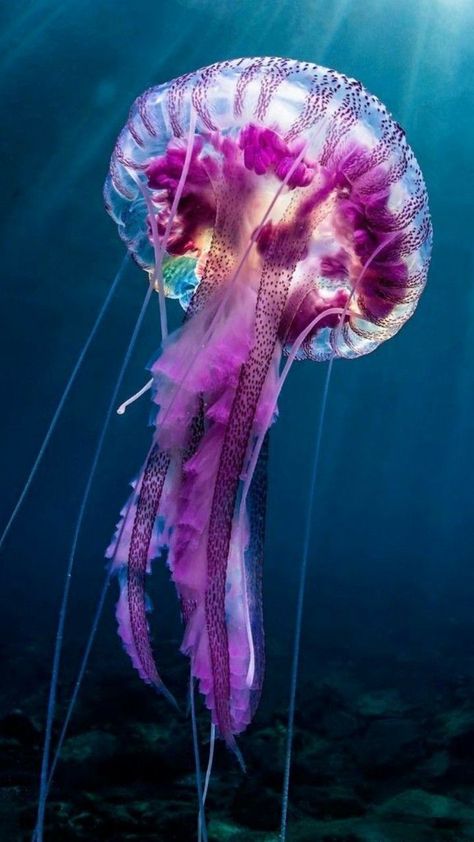 Undersized fish or fish over the limit should be released to ensure the future of fish populations.
Undersized fish or fish over the limit should be released to ensure the future of fish populations.
More and more South Carolina fishermen now practice tag and release, which not only conserves resources but also provides information on growth and movement of fish.
Saltwater fishermen can further contribute to conservation by purchasing a Saltwater Recreational Fishing License, which is required to fish from a private boat or gather shellfish in South Carolina’s salt waters. Funds from the sale of licenses must be spent on programs that directly benefit saltwater fish, shellfish and fishermen.
Help ensure the outdoor enjoyment of future generations by strictly adhering to all rules, regulations, seasons, catch limits and size limits, and through the catch and release of saltwater game fish.
Glossary
- Coelenteron
- a simple digestive cavity, which acts as a gullet, stomach and intestine, with one opening for both the mouth and anus.
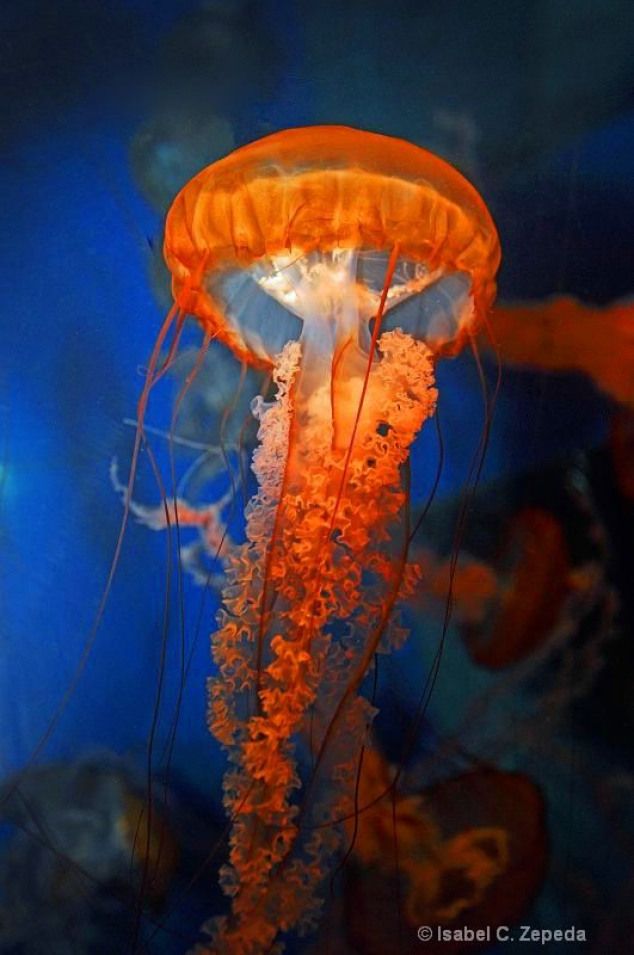
- Ephyra
- first stage that resembles the adult jellyfish
- Epidermis
- outer layer of the jellyfish
- Gastrodermis
- an inner layer which lines the gut
- Gonad
- reproductive organ
- Medusa
- adult form of the jellyfish
- Mesoglea
- middle jelly, or a layer of thick elastic jellylike substance
- Nematocyst
- A capsule inside the cnidoblast that contains a trigger and a stinging structure.
- Phylum Cnidaria
- a structurally simple marine group of both fixed and mobile animals: sea anemones, sea whips, corals and hydroids
- Radial symmetry
- a body plan where the body parts radiate from a central axis Planulae-small swimming larvae
- Scyphistoma
- flower-like polyps of the larval stage
This publication was made possible in part with funds from the sale of the South Carolina Saltwater Recreational Fishing License and the U.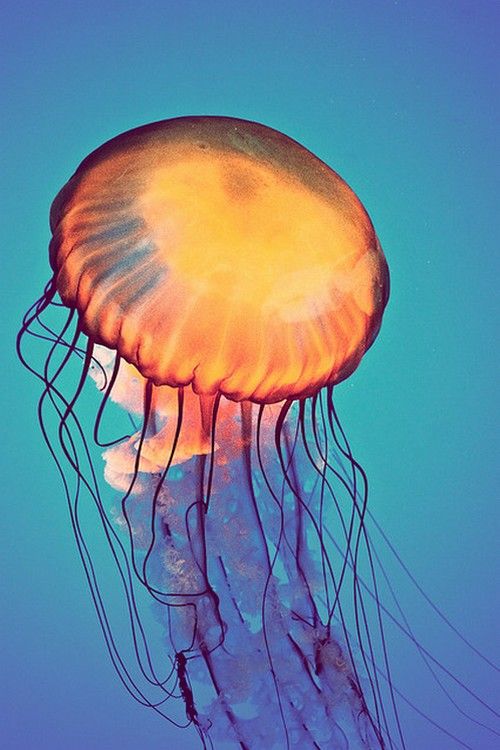 S. Fish and Wildlife Service Sportfish Restoration Fund. The South Carolina Department of Natural Resources publishes an annual Rules and Regulations booklet that lists all saltwater fishing regulations. Have an enjoyable fishing trip by reading these requirements before you fish.
S. Fish and Wildlife Service Sportfish Restoration Fund. The South Carolina Department of Natural Resources publishes an annual Rules and Regulations booklet that lists all saltwater fishing regulations. Have an enjoyable fishing trip by reading these requirements before you fish.
Author credentials: J. David Whitaker, Dr. Rachael King and David Knott, Marine Resources Division
The above information on the jellyfish is available in a brochure, please download the Sea Science - Jellyfish information pamphlet which is in the Adobe PDF file format. Adobe® Reader® is required to open the files and is available as a free download from the Adobe® Web site.
Peanut Butter and Jelly Fish
None Join Peanut Butter and Jellyfish as they show how to forgive and rescue! Peanut Butter, a sea horse, and Jellyfish are best friends. They love exploring up, down, around, and through their ocean home and often pass by Crabby the crab, who is very crabby; he’s always mean to Peanut Butter and Jellyfish.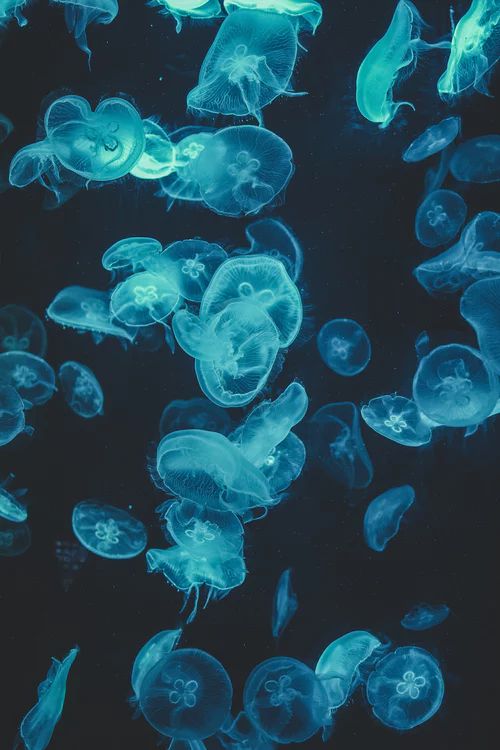 One day, Peanut Butter and Jellyfish don’t hear Crabby’s crabby remarks. Instead they see him caught in a trap being lifted to the surface. Oh no! What will the two friends do? Read along to this clever story that deals with big emotions like crabbiness, empathy, jealousy, and perspective taking. Has anyone ever been mean to you? Did you ask why? Try it. show full description Show Short Description
One day, Peanut Butter and Jellyfish don’t hear Crabby’s crabby remarks. Instead they see him caught in a trap being lifted to the surface. Oh no! What will the two friends do? Read along to this clever story that deals with big emotions like crabbiness, empathy, jealousy, and perspective taking. Has anyone ever been mean to you? Did you ask why? Try it. show full description Show Short Description Friendship Stories
Enjoy short stories about friendship for kids including fan favorites such as Mike's Seach for Squirt and Peanut Butter and Jellyfish.
view all
Peanut Butter and Jelly Fish
Santa and Baby
Mike's Search For Squirt
Gratitude
One membership, two learning apps for ages 2-8.
TRY IT FOR FREE
Full Text
Peanut Butter and Jellyfish were the best of friends— best of friends who spent their days exploring up, down, around, and through their grand ocean home.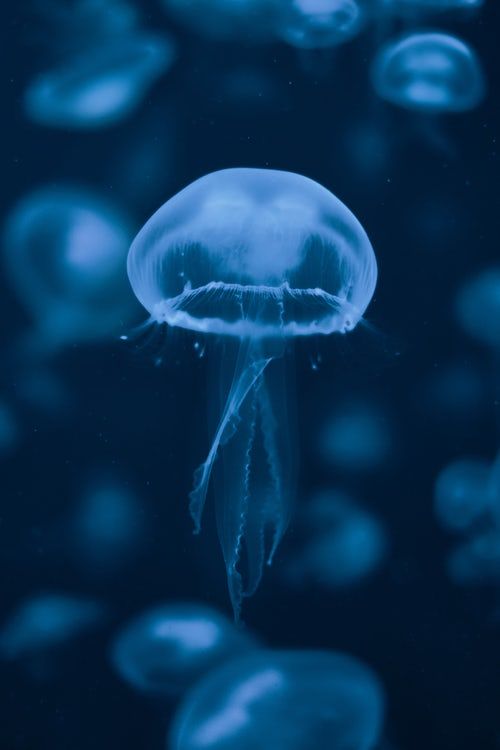 Unluckily for them, though, they lived near Crabby. “You guys swim like humans!” he would taunt as they slipped past. Peanut Butter and Jellyfish did their best to ignore the heckler. “Did you hear something?” asked Jellyfish. “No, must be the current,” said Peanut Butter. Crabby was relentless. “You guys smell like rotten barnacles! Pee-yew!” “My grandma called. She wants her run-walk shoes back!” “I’ve seen sea snails swim with more style.” “What a bunch of bubbleheads!” Jellyfish puffed up his chest and said, “Driftwood and sea stones may break our bones, but words will never hurt us.” “You’re an invertebrate! You don’t even have any bones,” huffed Crabby as he marched along his favorite rock by himself. One day, as Peanut Butter and Jellyfish set out on an excursion to the great reef, they swam past Crabby’s perch. They braced themselves for the usual insults. But all was quiet. Then they heard the faint sound of sobbing up ahead. It was Crabby! He was caught in a lobster trap. And it was being lifted to the surface! “I-I-I’m scared,” he cried.
Unluckily for them, though, they lived near Crabby. “You guys swim like humans!” he would taunt as they slipped past. Peanut Butter and Jellyfish did their best to ignore the heckler. “Did you hear something?” asked Jellyfish. “No, must be the current,” said Peanut Butter. Crabby was relentless. “You guys smell like rotten barnacles! Pee-yew!” “My grandma called. She wants her run-walk shoes back!” “I’ve seen sea snails swim with more style.” “What a bunch of bubbleheads!” Jellyfish puffed up his chest and said, “Driftwood and sea stones may break our bones, but words will never hurt us.” “You’re an invertebrate! You don’t even have any bones,” huffed Crabby as he marched along his favorite rock by himself. One day, as Peanut Butter and Jellyfish set out on an excursion to the great reef, they swam past Crabby’s perch. They braced themselves for the usual insults. But all was quiet. Then they heard the faint sound of sobbing up ahead. It was Crabby! He was caught in a lobster trap. And it was being lifted to the surface! “I-I-I’m scared,” he cried.![]() Surely, he was doomed. “Should we help?” asked Jellyfish. The two friends shared a look. “He is in serious trouble,” said Peanut Butter. “You’re right. We have to help!” exclaimed Jellyfish. “But how?” “I have a plan,” said Peanut Butter. “Follow me.” They swam up to the lobster trap. Peanut Butter used his tail to unlock the trap’s gate, but Crabby didn’t budge. “Come on. You’re free!” said Peanut Butter. “But-but . . . I can’t swim,” confessed Crabby. “And I’m afraid of heights.” The lobster trap was getting pulled closer to the surface! “Plan B!” exclaimed Jellyfish. He worked furiously on untying the trap’s knot. “Hurry!” cried Peanut Butter. “I can see the fishermen above!” Just when all hope was lost . . . The knot gave out, sending the trap plummeting! Peanut Butter and Jellyfish grabbed ahold and lowered it to safety. Crabby’s legs wobbled as he returned to his favorite rock. “Th-thanks, you t-two,” he stuttered. “Y-You know, I’m sorry for saying those mean things,” Crabby said.
Surely, he was doomed. “Should we help?” asked Jellyfish. The two friends shared a look. “He is in serious trouble,” said Peanut Butter. “You’re right. We have to help!” exclaimed Jellyfish. “But how?” “I have a plan,” said Peanut Butter. “Follow me.” They swam up to the lobster trap. Peanut Butter used his tail to unlock the trap’s gate, but Crabby didn’t budge. “Come on. You’re free!” said Peanut Butter. “But-but . . . I can’t swim,” confessed Crabby. “And I’m afraid of heights.” The lobster trap was getting pulled closer to the surface! “Plan B!” exclaimed Jellyfish. He worked furiously on untying the trap’s knot. “Hurry!” cried Peanut Butter. “I can see the fishermen above!” Just when all hope was lost . . . The knot gave out, sending the trap plummeting! Peanut Butter and Jellyfish grabbed ahold and lowered it to safety. Crabby’s legs wobbled as he returned to his favorite rock. “Th-thanks, you t-two,” he stuttered. “Y-You know, I’m sorry for saying those mean things,” Crabby said.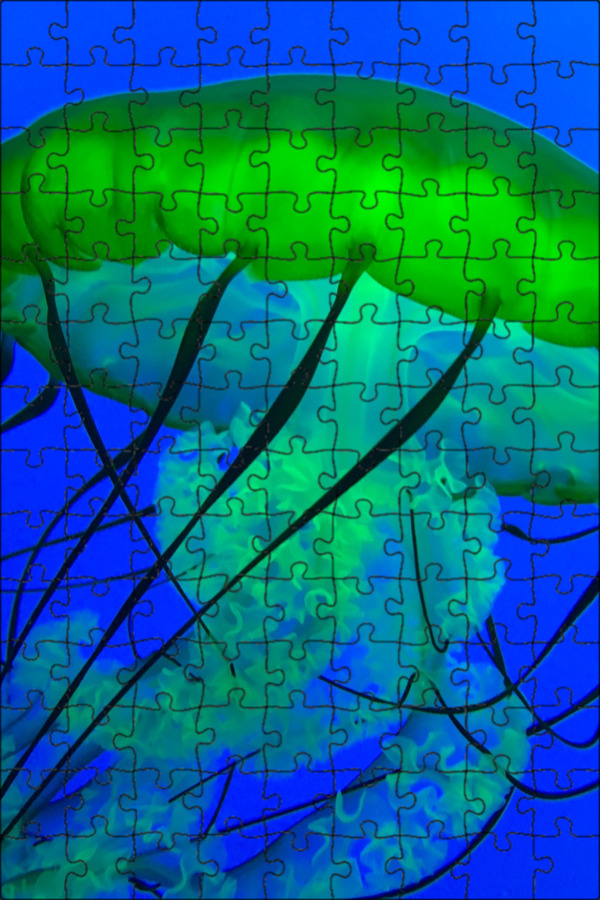 He may have been afraid of heights, but Crabby was brave enough to apologize. “I-I guess I was jealous. You guys seem like you’re always having so much fun explorin’ the open waters.” “Well, there’s plenty to explore close to the ocean floor!” said Jellyfish. Peanut Butter and Jellyfish still swam up, down, around, and through. But it was on the ocean floor that they found their greatest treasure!
He may have been afraid of heights, but Crabby was brave enough to apologize. “I-I guess I was jealous. You guys seem like you’re always having so much fun explorin’ the open waters.” “Well, there’s plenty to explore close to the ocean floor!” said Jellyfish. Peanut Butter and Jellyfish still swam up, down, around, and through. But it was on the ocean floor that they found their greatest treasure!
1
We take your child's unique passions
2
Add their current reading level
3
And create a personalized learn-to-read plan
4
That teaches them to read and love reading
TRY IT FOR FREE
Jellyfish destroy fish and frighten tourists off the coast of Britain
MOSCOW, August 19 - RIA Novosti. Hordes of jellyfish, which are becoming more and more off the coast of Britain, threaten fishing and fish farms, as well as tourists who can suffer from burns, writes the British newspaper Independent.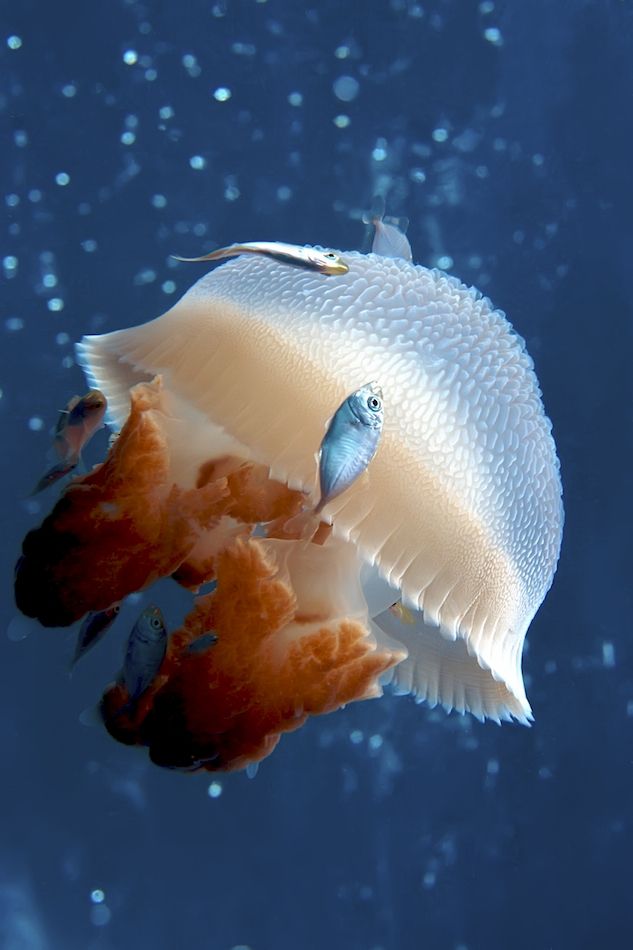
"This is a serious threat. Maybe in 20 years we will not be ordering traditional fish and chips, but jellyfish with potatoes," said Swansea University professor Graeme Hays.
Jellyfish are the least known of marine life, but they are causing increasing damage to tourism, aquaculture and fisheries, and their numbers are rapidly increasing.
Numerous cases of burns among swimmers in the Mediterranean, as well as significant damage to fisheries from the shores of the Black Sea to the South Atlantic, prompted joint research by scientists from the universities of Swansea and Cork.
According to the newspaper, British and Irish scientists led by Hayes have launched a large-scale Ecojel project, which plans to use the latest technological innovations, in particular, scientists will mark jellyfish in order to monitor their life cycle and their movements.
Experts hope to test the theory that overfishing may be one of the reasons for the increase in the number of jellyfish.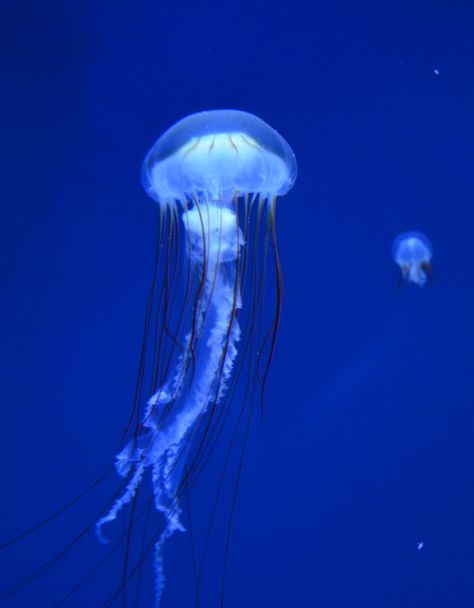 Jellyfish and fish fry feed on the same plankton, and if one part is reduced, then the second, respectively, increases.
Jellyfish and fish fry feed on the same plankton, and if one part is reduced, then the second, respectively, increases.
"We know very little about jellyfish, despite the fact that their population growth may be driven by overfishing and climate change, and this could have significant social and economic impacts," said Hayes.
Last November, Northern Ireland's only salmon farm was attacked by jellyfish, killing over 100,000 fish. Millions of small jellyfish known as "lilac stingers" have approached the cages, located a kilometer from the coast in the Irish Sea near Glenarm Bay and Cashendan.
Then jellyfish covered a surface of about 16 square kilometers and a depth of about ten meters, and although the rescuers tried to save the cages, this was not possible, because there were too many fish. The farm's CEO, John Russell, said he had never seen anything like it in his 30 years of operation.
"The sea turned red from these jellyfish and there was nothing we could do about it, absolutely nothing," he said.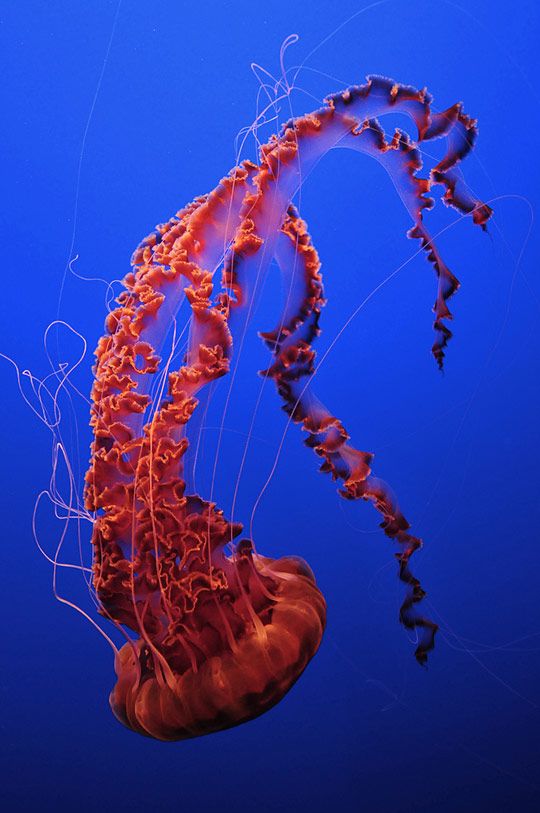 And even earlier in the summer, visitors to beaches in Cornwall and Dorset were warned of the danger from poisonous jellyfish - the so-called "Portuguese warships".
And even earlier in the summer, visitors to beaches in Cornwall and Dorset were warned of the danger from poisonous jellyfish - the so-called "Portuguese warships".
The threat to bathers is also growing. Burns from some species of jellyfish found off the coast of Britain - such as "Lion's Mane" - can cause death. The project will enable a broad study of the impact of jellyfish on the Irish Sea ecosystem, he added.
Professor Hayes and his Irish colleague Professor Tom Doyle are going to attach special sensors - small devices that record information about the temperature of the water and its depth - to large cornerot jellyfish, which are now found off the coast of Britain and which in diameter can reach one meters.
After the death of an individual, it is hoped that these sensors will be washed ashore and they will be found. Experiments have shown that this kind of data collection works.
The scientists hope that they can develop a strategy to manage the fish farms to avoid the jellyfish problem, but they will also look into the possibility of breeding certain types of jellyfish for human consumption.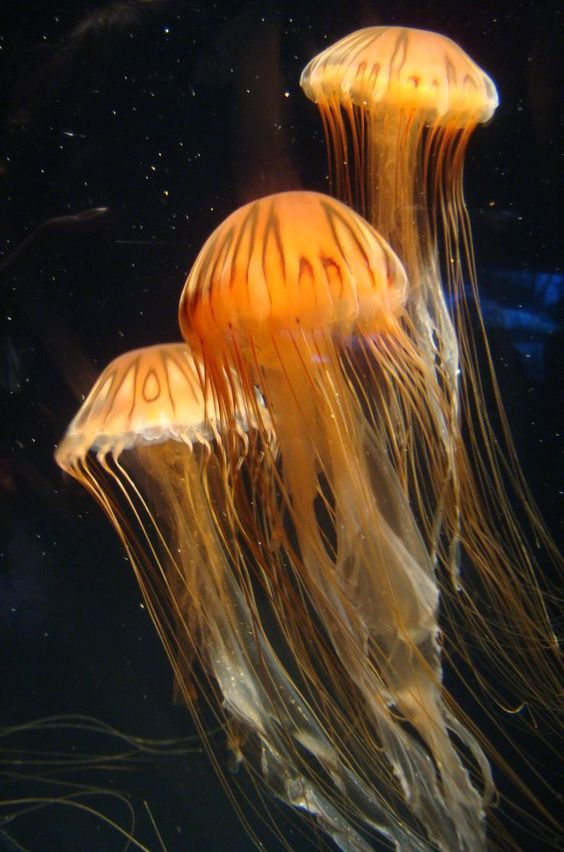 This is already being done in Asia, and it is developing there. Scientists also intend to collect all available information regarding the treatment of burns from different types of jellyfish.
This is already being done in Asia, and it is developing there. Scientists also intend to collect all available information regarding the treatment of burns from different types of jellyfish.
interesting facts, types, structure and features
Among all creatures on the planet, jellyfish are one of the most ancient. Scientists say that they lived in the expanses of water hundreds of millions of years ago. These creatures are found both in the seas and oceans. They differ in appearance, because some are attractive, while others, to put it mildly, are rejected. Some of them are not dangerous, and some carry a hidden threat, so we have collected all interesting facts about jellyfish and combined them into one list.
1. The largest jellyfish is referred to as the Arctic giant and its size is really impressive. It was possible to find an individual in which the diameter of the dome is almost 2.5 meters, and the length of the entire body, taking into account the tentacles, is over 35 meters.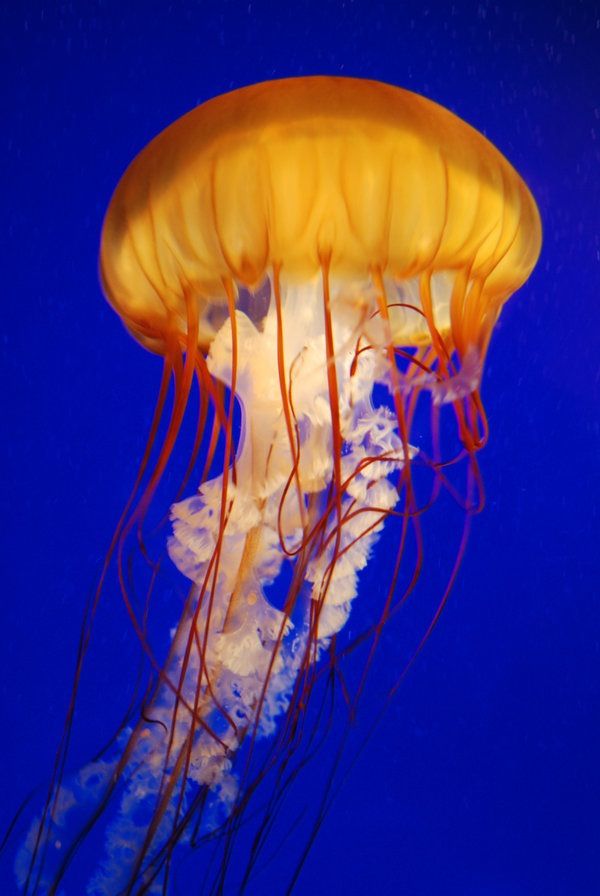
2. It has long been believed that fish soothe themselves, so often people buy aquariums for themselves and admire the inhabitants of the seas, feeding them. In Japan, jellyfish are bred for the same purpose, because the researchers of this country have found that their monotonous, smooth movements completely help to strengthen the nervous system.
3. An interesting fact about jellyfish for children. Their largest concentration is in the lake of the same name on the Rocky Archipelago. According to preliminary estimates, there are more than two million individuals there, and this despite the fact that the lake itself is 450 meters long and only 170 wide.
4. The creature has no lungs, it captures oxygen mixed with water with its whole body. At the same time, the jellyfish also does not have a brain, but has two nervous systems and two dozen eyes.
5. Among the most interesting facts about jellyfish is box jellyfish and its capabilities. The creature can reach speeds of up to two meters per second and at the same time has a deadly powerful poison. One even the slightest touch to her is deadly, and in total the poison that is in her body is enough to send at least fifty people to the next world.
The creature can reach speeds of up to two meters per second and at the same time has a deadly powerful poison. One even the slightest touch to her is deadly, and in total the poison that is in her body is enough to send at least fifty people to the next world.
6. Despite the simplicity of the structure of the body, jellyfish are capable of movement. They swallow some of the water into themselves, and then push it back out. But this happens extremely rarely, most often they prefer to follow the flow, completely inactive.
7. Jellyfish are regularly used in medicine. Back in the Middle Ages, it was possible to find out that a separate part of their body called cornerot has a laxative property. Nowadays, the poison of these creatures is actively used, because it makes drugs more effective, which contributes to the normalization of blood pressure.
8. The life cycle of a jellyfish is unique. It starts with eggs, from which later planulas are born, they resemble a shoe that has been enlarged a thousand times infusoria, which drifts in the water surface until something solid meets its path, be it a reef, a rock, or maybe the bottom.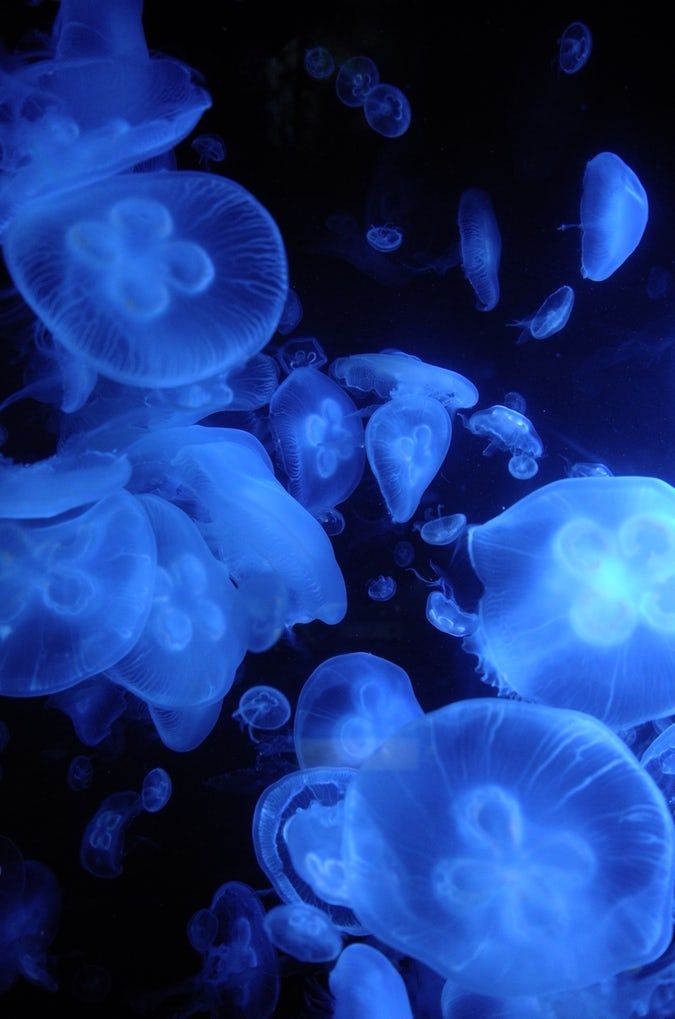 Attached to it, it forms a polyp, which gradually grows and forms into something more resembling a jelly-like creature. Sometimes a month later, and sometimes a year later, the modified polyp detaches itself and a jellyfish appears before the world.
Attached to it, it forms a polyp, which gradually grows and forms into something more resembling a jelly-like creature. Sometimes a month later, and sometimes a year later, the modified polyp detaches itself and a jellyfish appears before the world.
9. Any animal known to be venomous will usually strike its prey with a bite. But jellyfish are a clear exception, because for this they have special organs called nematocysts. Feeling threatened, they stimulate them with such force that they literally explode, hitting the opponent's body with a hundred drops of deadly poison.
10. There is an assumption that one of these creatures is immortal. Scientists managed to establish that Turritopsis dornii, already being absolutely adults, can return to the state of a polyp and, in theory, they can do this indefinitely. However, it was possible to check this only in the laboratory, because in reality in real life they are either eaten or thrown ashore sooner or later.
About jellyfish for children
This article provides information about jellyfish for children
One of the amazing facts about jellyfish is that they are 95% water.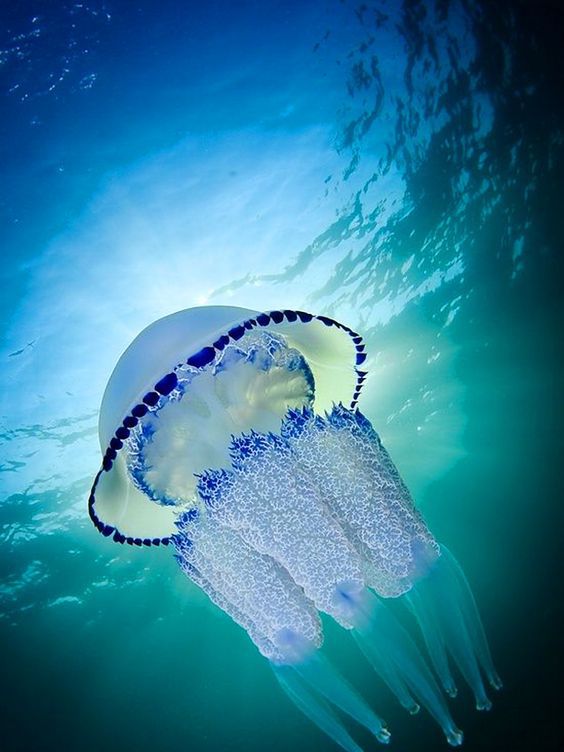 Would you believe that the largest jellyfish grows up to 183 cm in diameter with tentacles, and its body length is about 30.5 m?
Would you believe that the largest jellyfish grows up to 183 cm in diameter with tentacles, and its body length is about 30.5 m?
Given their bright appearance, it's hard to believe that some of these almost transparent jellyfish can bite people and cause death. Fortunately, not all jellyfish are poisonous and/or dangerous to humans. The venom is injected to paralyze the prey before eating it. There are over 2,000 species of jellyfish, learning the facts about jellyfish captivates many avid marine biologists. More information about jellyfish for children can be found below.
Fun facts about jellyfish for kids
Jellyfish belong to the type Cnidaria , whose characteristic feature is a gelatin-like inanimate body located between the epithelial layers. According to evolutionary studies, these curious sea creatures predated the massive reptiles (dinosaurs) on Earth. Since then, they have survived in various water conditions, in cold and warm waters, in shallow water and in deep sea water.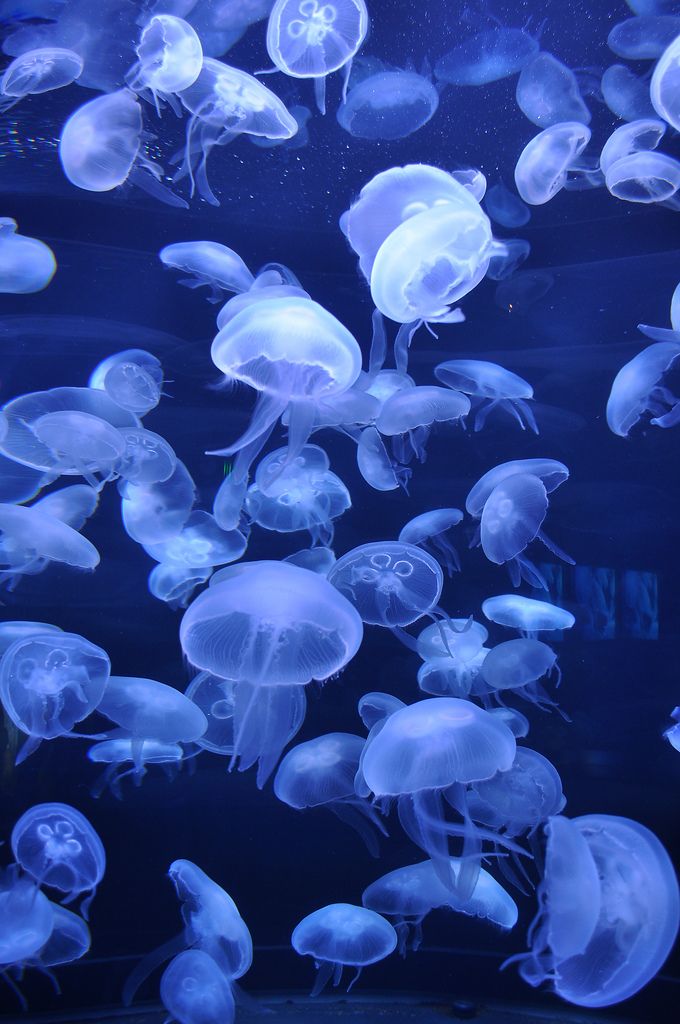 Next, find out some amazing jellyfish facts for kids.
Next, find out some amazing jellyfish facts for kids.
Medusa. Color and size Depending on the type of jellyfish, their color can be white, pink, yellow, orange, red, blue, green and multicolor. Would you believe that the width of the largest jellyfish - box jellyfish is about 183 cm? Their variable size and radially symmetrical body are also their distinguishing characteristics. Some species of jellyfish can be about 2.5 cm in diameter, others can reach 4 m.0005
Medusa. Nutrition Below on the domed or bell-shaped body is the mouth of a jellyfish, surrounded by tentacles. So what do jellyfish eat? They are true carnivores, feeding on small marine organisms, zooplankton, ctenophores, crustaceans and sometimes other jellyfish . After absorption of beneficial nutrients, waste products are excreted through the mouth opening. Predators for jellyfish are sunfish, sea turtles, plataxids and large marine animals.
Medusa. Movement The movement of jellyfish is largely dependent on the current of the ocean, tides, ebbs and air currents. Although they are less capable of horizontal locomotion, jellyfish can control vertical locomotion through muscle contractions. Some of them are sensitive to light and swim below during the daytime. Jellyfish need water to survive. Lack of water leads to desiccation and death of these gelatinous marine animals.
Poison jellyfish You may have seen a jellyfish with a body structure similar to a cubic umbrella. Such jellyfish are box jellyfish. An important fact that children should be aware of is that they are naturally venomous and they produce painful bites. The box jellyfish has several tentacles, each with approximately 500,000 nematocytes. These special cages contain poison for the bites of predators and humans that get in the way of the jellyfish.
One of the species box jellyfish , known as "sea wasp" (scientific name Chironex fleckeri ) is considered the most poisonous species, due to the highest number of deaths from it.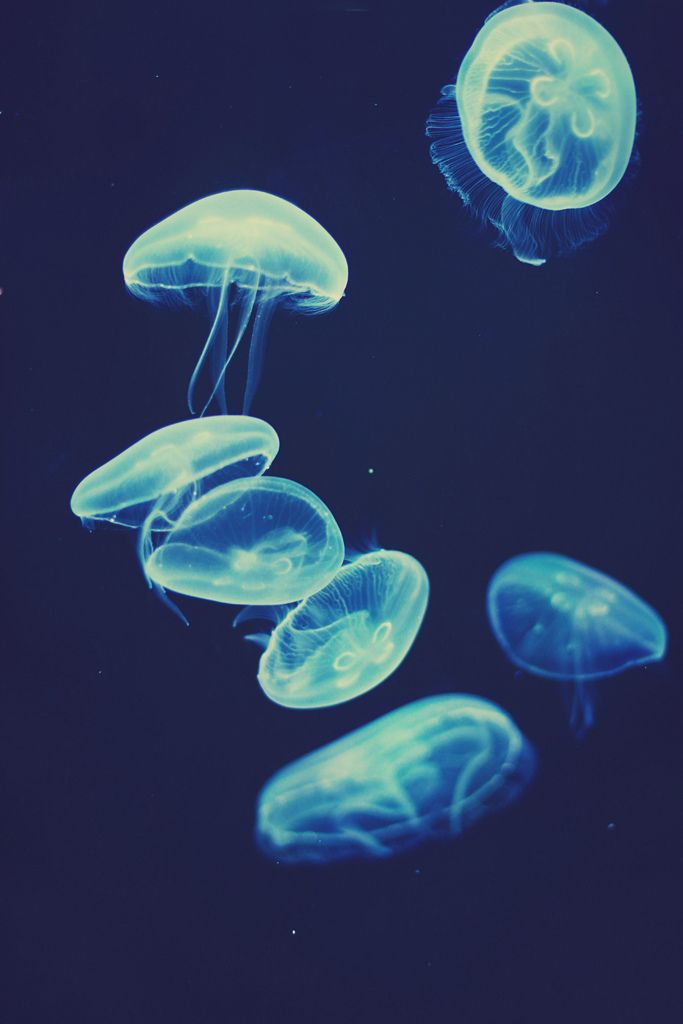 In the Philippines, the number of deaths from this deadly jellyfish is 20-40 cases per year. Other poisonous species of jellyfish are the Irukandji jellyfish Malo kingi and Carukia barnesi.
In the Philippines, the number of deaths from this deadly jellyfish is 20-40 cases per year. Other poisonous species of jellyfish are the Irukandji jellyfish Malo kingi and Carukia barnesi.
Treatment of jellyfish stings Luckily, box jellyfish do not intentionally attack humans. However, anyone who accidentally gets too close to her tentacles can be bitten by this jellyfish . There are some disturbing facts about baby jellyfish. To save a person's life, immediate treatment for a jellyfish sting is required. An effective first aid is to pour a small amount of vinegar over the bite site. If the wound is left untreated, the poison can soon worsen the functioning of the heart. The venom of this jellyfish is neurotoxic, which can lead to the death of a child within three minutes.
Jellyfish as food Jellyfish are eaten in many parts of the world. Non-poisonous species of jellyfish are available on the international market for culinary purposes.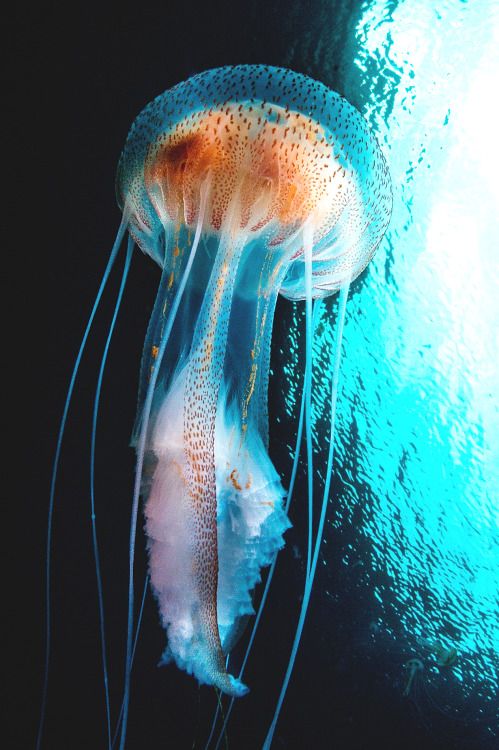 After catching jellyfish, the procedure for their preparation follows, during which their mucous lining and gonads are removed. The remaining edible parts are treated with salt and a mixture of alum. The final product sold on the market is salty and crunchy in taste.
After catching jellyfish, the procedure for their preparation follows, during which their mucous lining and gonads are removed. The remaining edible parts are treated with salt and a mixture of alum. The final product sold on the market is salty and crunchy in taste.
Information about Aurelia eared is also quite interesting for children. The big-eared aurelia also bites, but its bite is more painless and short-lived. This is a species of small jellyfish that barely live for 6 months in their natural habitat. The causes of death after breeding are: lack of food, high temperature and disease. However, in a controlled aquarium environment where there are no predators or competition for food, they can live for years.
Isn't this information about jellyfish interesting for children? The most important information about jellyfish is that they have a transparent body and poisonous tentacles that are difficult for swimmers and divers to notice. If they accidentally swim up to the jellyfish, after just a few seconds, the jellyfish injects its venom from its tentacles.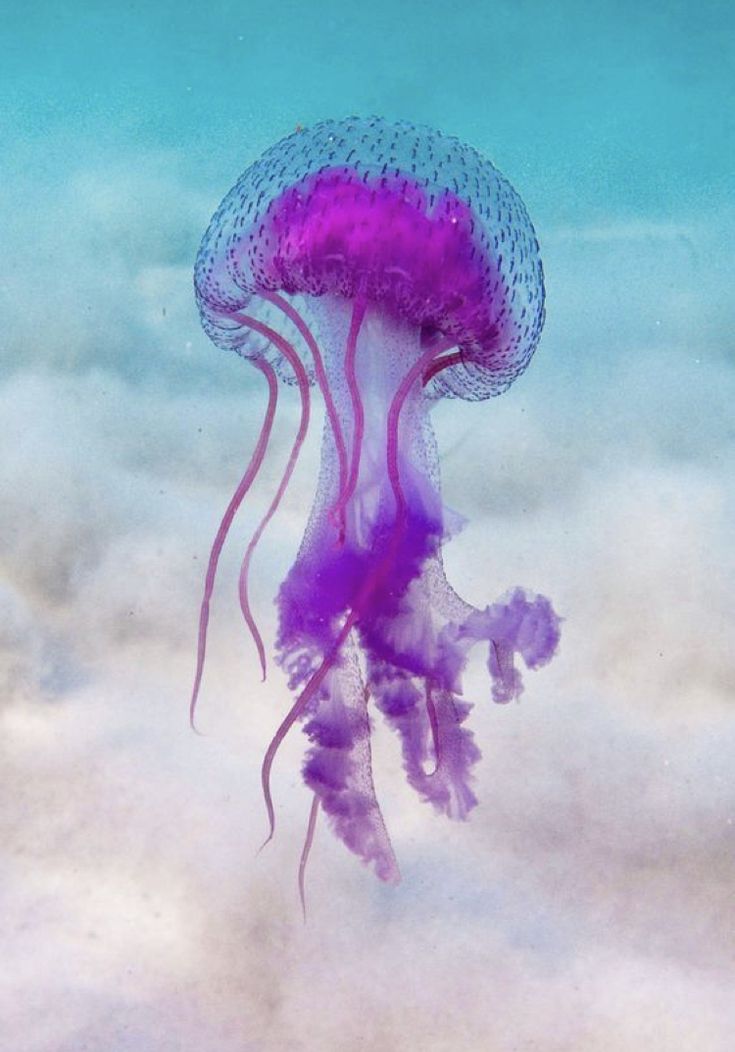 To avoid such incidents, people should take precautions before diving into water in regions where there are many jellyfish .
To avoid such incidents, people should take precautions before diving into water in regions where there are many jellyfish .
Objectives:
To expand and deepen children's understanding of the jellyfish.
Show children natural connections in nature.
Dictionary: scuba.
To develop the small muscles of the hands of children.
To cultivate interest in nature, the desire to learn something new about it.
Equipment:
Photos of jellyfish, underwater seascape painting, paper, scissors, glue, brushes, napkins.
Aurelia jellyfish
Cornerot Medusa
Lesson progress:
Today we will travel to the underwater kingdom of the sea.
But can a person stay under water for a long time? Why? (Answers of children). Of course, we all need air to breathe. Do you know what device the French explorer came up with in order to stay under water for a long time? (Answers of children).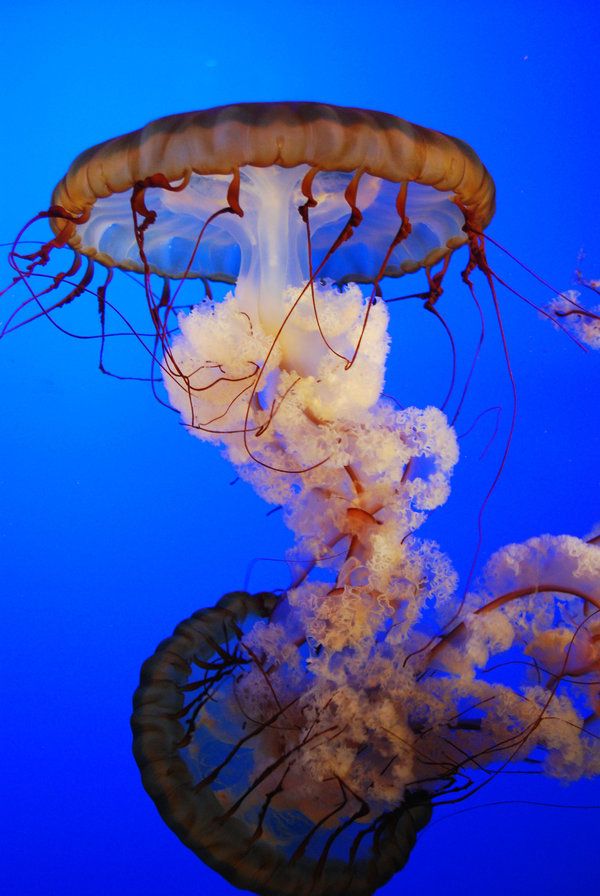 This device is called scuba gear. We have already met words beginning with "aqua" more than once. Remember them. (Answers of children). Aquarium, water park, watercolor. The meaning of these words is somehow connected with water. "Aqua" - this is water, only in another language, in Latin.
This device is called scuba gear. We have already met words beginning with "aqua" more than once. Remember them. (Answers of children). Aquarium, water park, watercolor. The meaning of these words is somehow connected with water. "Aqua" - this is water, only in another language, in Latin.
Put on your scuba gear and start diving into our sea. What is it called? (Answers of children). (Imitation of putting on a scuba gear and diving).
Who can we meet in the waters of our Black Sea? (Answers of children). There are dolphins, and mussels, and rapana, and katran, and anchovy.
And here is the mysterious jellyfish. Take a look at the picture.
In summer and autumn, there are many jellyfish near the Crimean coast. They clog fishing nets, interfere with those who swim in the sea, sometimes they are thrown ashore by a wave. They were called differently: sea fat, sea moon, sea heart. Why do you think? (Answers of children).
Many different small jellyfish live in our sea, there are also large ones.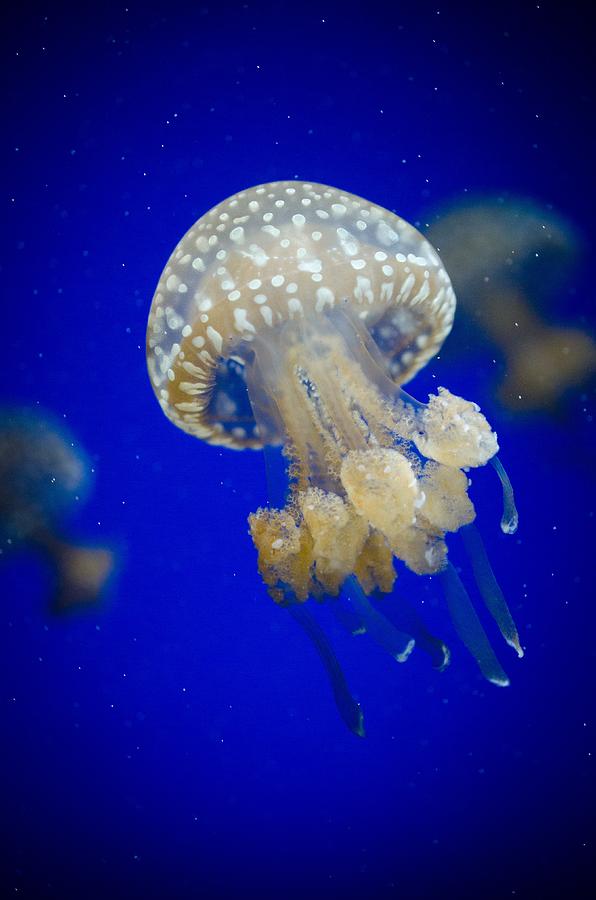 They are armed. Under the umbrella they have stinging cells. Take a look at the photo. Here they are, like tentacles. If an enemy approaches a jellyfish, it can burn it with its stinging cells. This burn resembles a nettle burn. Hence also such names of jellyfish as a bug, sea nettle. For jellyfish enemies, this burn is dangerous, but for a person it is not so dangerous, but painful. So when you meet a large jellyfish, look at it, admire it, but do not approach or touch it.
They are armed. Under the umbrella they have stinging cells. Take a look at the photo. Here they are, like tentacles. If an enemy approaches a jellyfish, it can burn it with its stinging cells. This burn resembles a nettle burn. Hence also such names of jellyfish as a bug, sea nettle. For jellyfish enemies, this burn is dangerous, but for a person it is not so dangerous, but painful. So when you meet a large jellyfish, look at it, admire it, but do not approach or touch it.
Jellyfish move by contracting their umbrellas. Connect the fingertips of both hands and round the palms so that you get a hemisphere - that's the jellyfish umbrella. Now try to show how it shrinks. Here the jellyfish swims slowly, but faster. (Finger gymnastics is performed). And now the jellyfish is swimming fast. Soon there will be a storm at sea. How many of you know the name of a sea storm? (Answers of children). Shortly before a storm, jellyfish swim away from the shore. Scientists have noticed this and are using it to warn of an impending storm.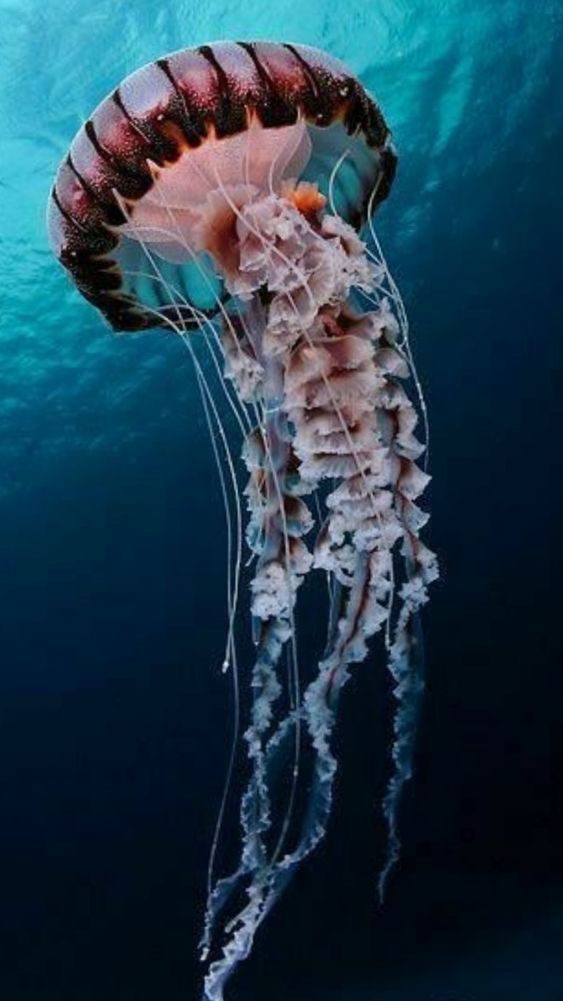
Previously, it was believed that the jellyfish has no eyes and, therefore, it does not see anything. But one Russian scientist carefully observed the jellyfish and noticed that they were striving from the darkness towards the light. So jellyfish see the light! But no one believed this scientist. But he did not give up and found jellyfish eyes on tentacles. It is not for nothing that they say: "patience and work will grind everything."
And now the game. Get in a circle, take the ball. You already know a lot about nature. For example, about the fact that everything in nature is interconnected, someone takes care of someone, someone eats someone. Whoever I throw the ball to should continue my sentence.
1. A hare is food for … (wolf, fox).
2. Honey is a favorite delicacy ... (bear).
3. Insects are eaten - ... (birds).
4. Sea raven cormorant eats - ... (fish).
5. Deer eat - ... (grass).
6. Plankton is food - ... (whales).
7. They feast on fish - .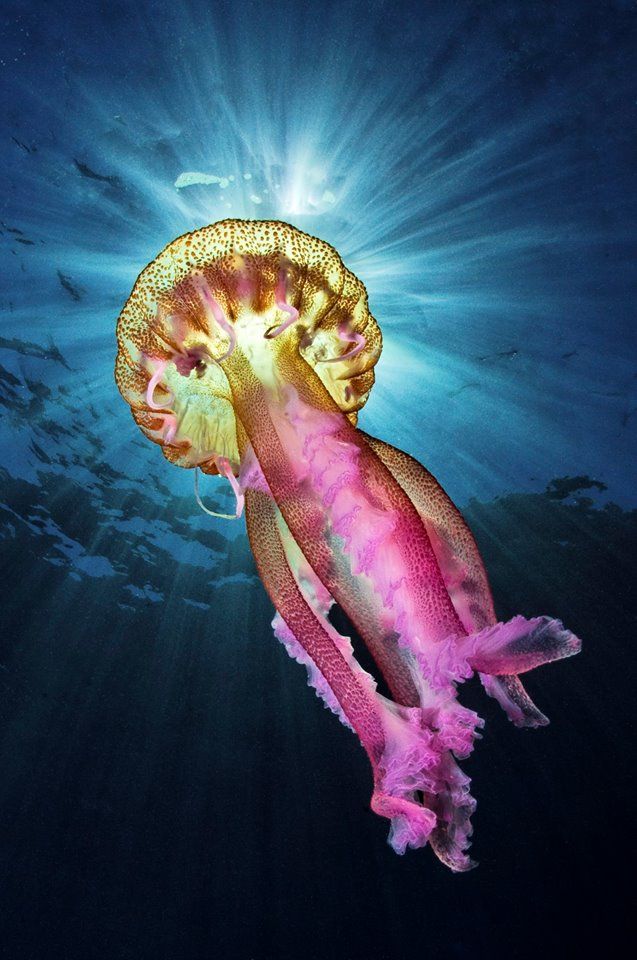 .. (sharks, gulls, etc.)
.. (sharks, gulls, etc.)
Imagine that no one eats jellyfish. These are amazing creatures that no one encroaches on them. Except human. Jellyfish are eaten in China and Japan. And the jellyfish themselves eat plankton. But under the umbrellas of jellyfish, young horse mackerels are hiding. Until they grow up and gain strength. Predatory fish would like to eat babies, but they are afraid of jellyfish stinging cells. When horse mackerels grow up, they leave their shelter under the jellyfish umbrella and pay her black ingratitude: they bite the edges of the umbrella. This is how good is repaid with evil.
Medusa paper crafting
Now I would like to invite you to make a paper jellyfish. With the help of scissors, glue and, of course, your skillful hands, we will make just such a jellyfish. (Paper construction. Looking at crafts.)
Questions:
1. How does a jellyfish protect itself from enemies?
2. What does a jellyfish eat?
3. Who eats the jellyfish itself?
4.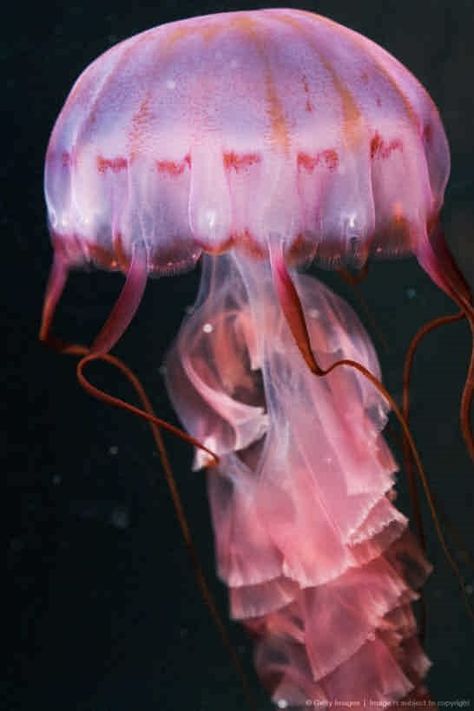 What is the name of a device for a long stay of a person under water?
What is the name of a device for a long stay of a person under water?
5. Who takes refuge under the jellyfish's umbrella?
6. How does a jellyfish move?
7. What do you know about the eyes of a jellyfish?
8. When do jellyfish swim away from the shore?
9. What names were given to the jellyfish?
You can invite children to compose stories about the adventures of a jellyfish, draw illustrations, arrange them in a book.
The legend of the jellyfish: "Heart of the sea"
Once two brothers were swimming in the sea. Here the elder, when he swam, quietly swam to the shore, and the younger - further and further from the shore. And the sea wave fell in love with the brave brother: she took him, hugged him tightly and pulls him to the bottom, to the underwater kingdom of the sea.
The lad resists, shouts, calls his brother for help. And the elder is afraid to swim. He thinks: “It’s deep there, I’ll drown with him!”.
- Oh, my dear brother! Oh, dear brother, save! - the last time the lad emerged, shedding tears.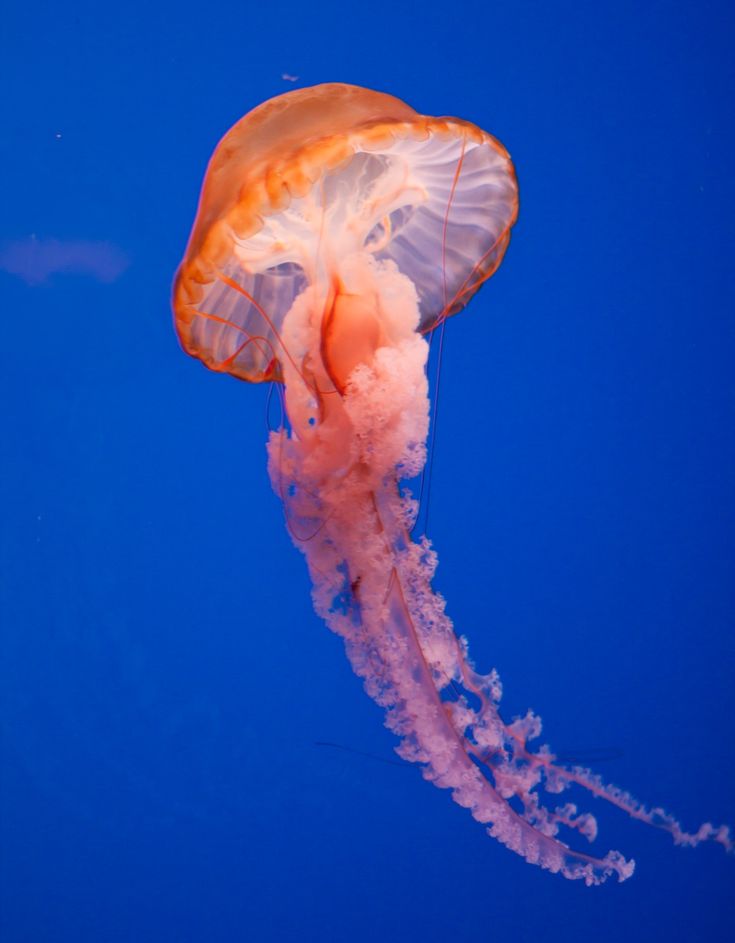
- May the Lord save you, - the elder said cowardly, but he himself did not dare to even look at how his brother was drowning, and quickly rowing to the shore, climbing onto a stone.
The wave got angry and chased the coward, overtook him, carried him into the sea and drowned him.
The queen of the sea sheltered her little brother at the bottom. And she turned his tears into sparkling pearls, and his curls into corals. And the older brother of fish and crayfish was dragged to the ground. Only no one wanted to touch the heart: that cowardly heart was so vile.
Since then, that heart has appeared in the sea. Timidly, stealthily swims, slippery, cold, burning like nettles, it moves sluggishly, trembles, there is not even a shadow from it - it is transparent. And the sea disdains the heart: it throws it on the shore, and there it dies without a trace.
Many of those who rested on the sea, faced with jellyfish. This helped to realize the fact that they cannot be called ordinary and harmless creatures.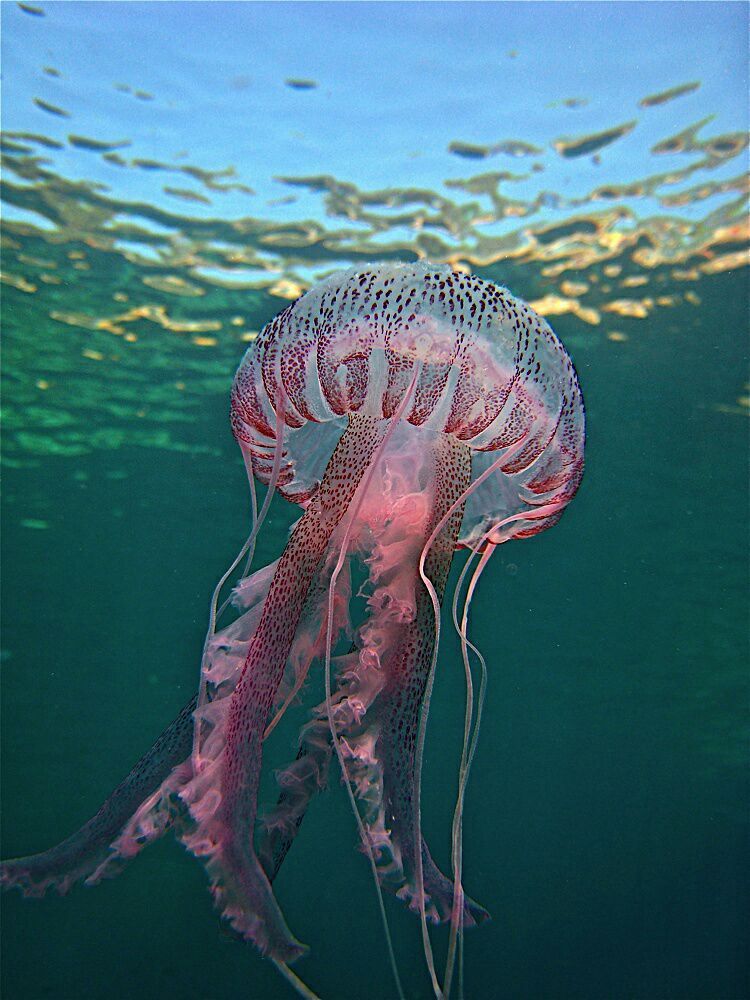 Consider some interesting facts about jellyfish.
Consider some interesting facts about jellyfish.
What does science know about jellyfish?
Researchers believe that jellyfish have existed for about 650 million years. They are found in all layers of each of the oceans. Various live in both salt and fresh water. Their primitive nervous system, which is located on the epidermis, allows you to perceive only smells and light. The nerve networks of jellyfish help them detect another organism through touch. These "animal plants", in fact, do not have a brain and sensory organs. They do not have a developed respiratory system, but breathe through thin skin that absorbs oxygen directly from the water.
Researching interesting facts about jellyfish, scientists noticed that these creatures can positively influence people who are experiencing stress. For example, in Japan they breed jellyfish in special aquariums. Their smooth and measured movements act as a sedative. Although such pleasure is expensive and brings additional troubles, in general it is justified.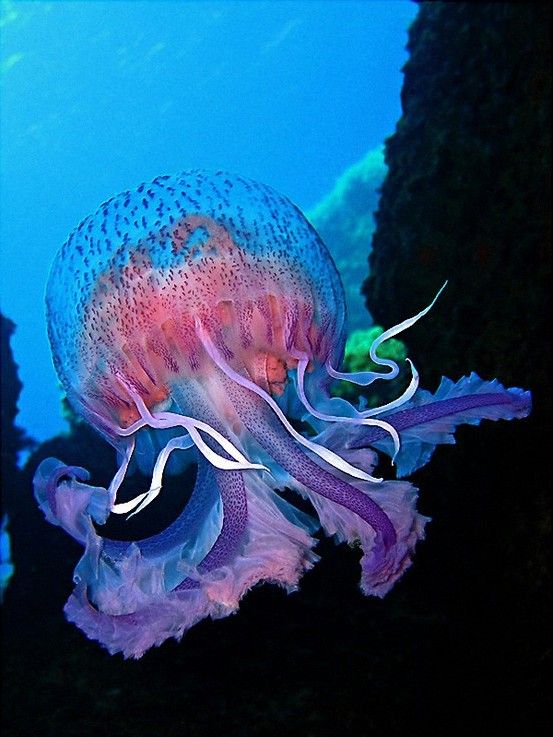
Jellyfish are over 90 percent water. The venom of their tentacles is used as a raw material for drugs that regulate blood pressure and for the treatment of respiratory diseases.
"Portuguese ship" it was called by some sailors of the XVIII century, who liked to talk to others about the jellyfish floating like a Portuguese warship of the Middle Ages. In fact, her body is very similar to this vessel.
Its official name is Physalia, but it is not a single organism. We are talking about a colony of jellyfish and polyps in different modifications, which interact very closely, and therefore look like one creature. The poison of some species of physalia is deadly to humans. Most often, the habitats of the Portuguese boat are limited to the subtropical parts of the Indian and Pacific oceans, as well as the northern bays of the Atlantic Ocean. In more rare cases, they are carried away by currents to the waters of the Caribbean and Mediterranean seas, to the shores of France and Great Britain, to the Hawaiian Islands and the Japanese archipelago.
These jellyfish often swim in large groups of several thousand in warm waters. The transparent and shiny jellyfish body rises about 15 centimeters above the water and moves along a chaotic trajectory regardless of the wind. Those individuals that swim near the shore are often thrown onto land by powerful winds. In the warm season, the physalia swims away from the coast, it moves with the flow towards one of the poles of the earth.
Characteristic features of physalia
Other interesting facts about this type of jellyfish relate to their unique features. Physalia is one of two species that can glow red. Another Portuguese warship uses its air bag filled with nitrogen, carbon dioxide and oxygen as a sail. If a storm is coming, the jellyfish releases a bubble and goes under the water. Near her tentacles, small perches like to swim, which do not feel the toxic environment, have serious protection from enemies, as well as food particles. Perches with their appearance attract other fish, which become food for these invertebrates.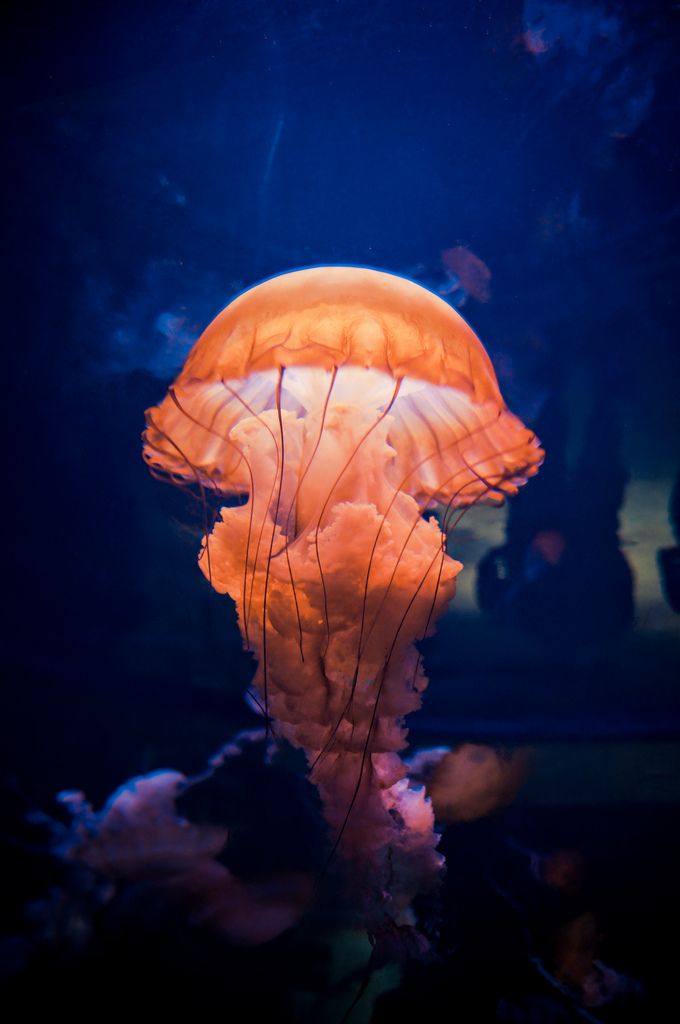 Here is such a symbiosis.
Here is such a symbiosis.
There are a number of species known today as physalia. In the Mediterranean Sea alone, researchers have discovered about 20 species of the Portuguese man-of-war.
Physalia jellyfish, interesting facts about reproduction
It is not known exactly how this jellyfish reproduces. However, scientific studies have shown that they reproduce asexually, and in each colony there are polyps that are responsible for reproduction. In fact, it is they who create new colonies. Portuguese boats are distinguished by the fact that they can breed continuously, so the number of nascent jellyfish is growing in the waters of the oceans and seas.
Another common version of the reproduction of physalia indicates that, when dying, the jellyfish leaves behind some organisms that show sexual characteristics, after which new individuals are formed. So far, this theory has not been proven.
About the tentacles of the Portuguese man-of-war
The interesting facts about the tentacles of the jellyfish are that their device is unique.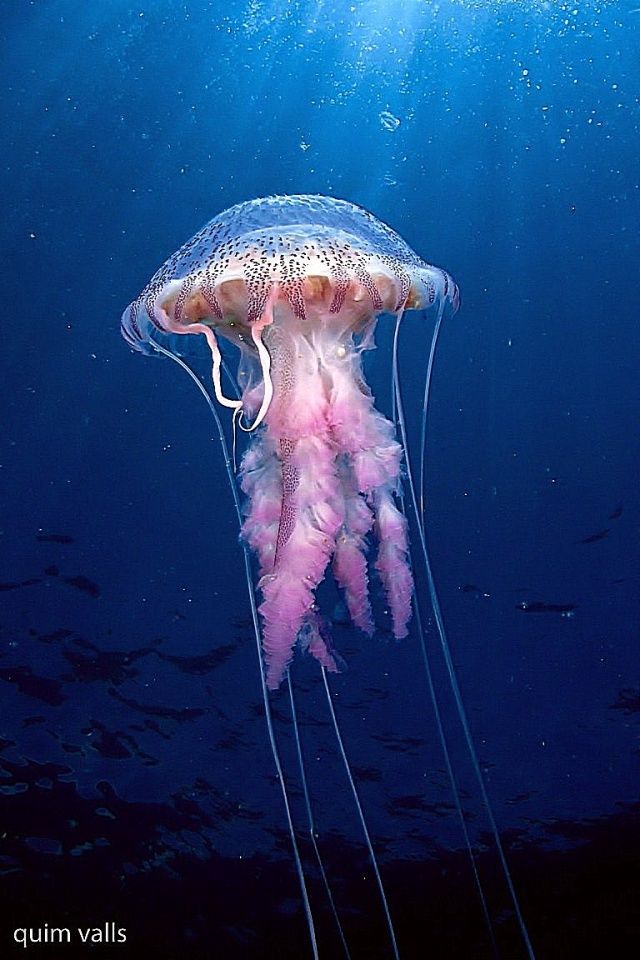 The "limbs" of jellyfish are equipped with a large number of capsules containing poison, the composition of which is similar to the poisonous substance of the cobra. Each of these small capsules is a hollow twisted tube with fine hairs. If contact occurs between the tentacles and the fish, the fish will die due to the stinging mechanism. When a person receives a burn from this jellyfish, he experiences a sharp pain, he will have a feverish state, and breathing will become difficult.
The "limbs" of jellyfish are equipped with a large number of capsules containing poison, the composition of which is similar to the poisonous substance of the cobra. Each of these small capsules is a hollow twisted tube with fine hairs. If contact occurs between the tentacles and the fish, the fish will die due to the stinging mechanism. When a person receives a burn from this jellyfish, he experiences a sharp pain, he will have a feverish state, and breathing will become difficult.
Interesting facts about jellyfish do not end there. The tentacles of these invertebrates can be up to 30 meters long. In addition, a person who is engaged in swimming, enjoying the process itself, will not always be able to see a bright blue-red bubble on the water and realize the danger that threatens it.
Irukandji jellyfish: interesting facts about the danger posed by it
This small jellyfish, which lives off the coast of Australia, produces poisonous substances that are stronger than cobra venom.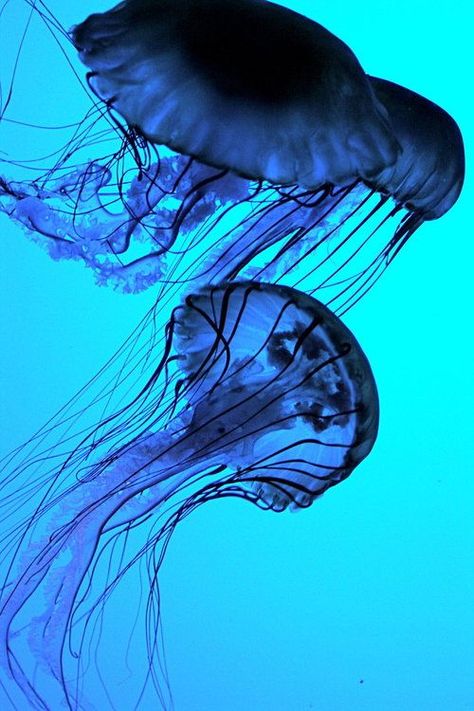 There are 10 types of Irukandji, 3 of which are deadly. The bite is almost imperceptible, but its consequences are a powerful heart attack, which in some cases can end in a painful death. And all this can happen in just 20 minutes. Since these invertebrates are too small and almost invisible, they can easily penetrate any barrier net that is designed for large creatures that pose a danger to swimmers and campers.
There are 10 types of Irukandji, 3 of which are deadly. The bite is almost imperceptible, but its consequences are a powerful heart attack, which in some cases can end in a painful death. And all this can happen in just 20 minutes. Since these invertebrates are too small and almost invisible, they can easily penetrate any barrier net that is designed for large creatures that pose a danger to swimmers and campers.
There are some other interesting facts about this species of jellyfish. Since the fishermen often fell ill with a strange disease after each trip to the sea, they realized that the reason for this was contact with some kind of sea creature. Medusa was named after the Irukandji tribe. Over time, thanks to Dr. Barnes, it was finally possible to establish that the cause of the diseases was contact with the jellyfish. Although its size is quite small, but the tentacles reach a length of 1 meter. The pain from the bite is so strong that it makes you double over, accompanied by intense sweating and vomiting, legs trembling violently.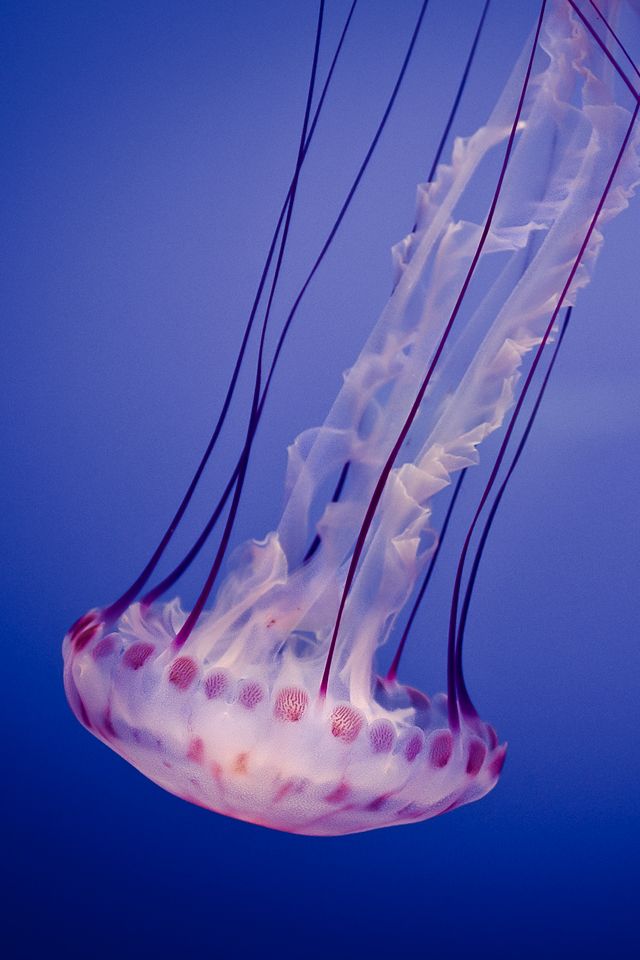
Conclusions
Although these invertebrates are difficult to see in the water, regardless of their size, it is still not worth while swimming in the sea, walking along the coast, to be careless and inattentive - for the sake of your health. Many species for human health and life.
However, they also perform useful functions in their habitats and are used in medicine as a raw material for preparations. And who knows, maybe humanity will be able to get even more benefits from jellyfish.
Each of us, while relaxing at the sea, came across jellyfish. Here are some interesting facts about jellyfish. These are very unusual creatures.
Scientists believe that jellyfish appeared 650 million years ago. They are found in every ocean in all layers - from the surface to the very depths. Some species of jellyfish have also been found in fresh water.
The word jellyfish (in the plural will be medusae) is common to a number of languages - Greek, Finnish, Portuguese, Romanian, Hebrew, Serbian and Croatian, Spanish, French and Italian, Hungarian, Polish, Czech and Slovak, Russian and Bulgarian.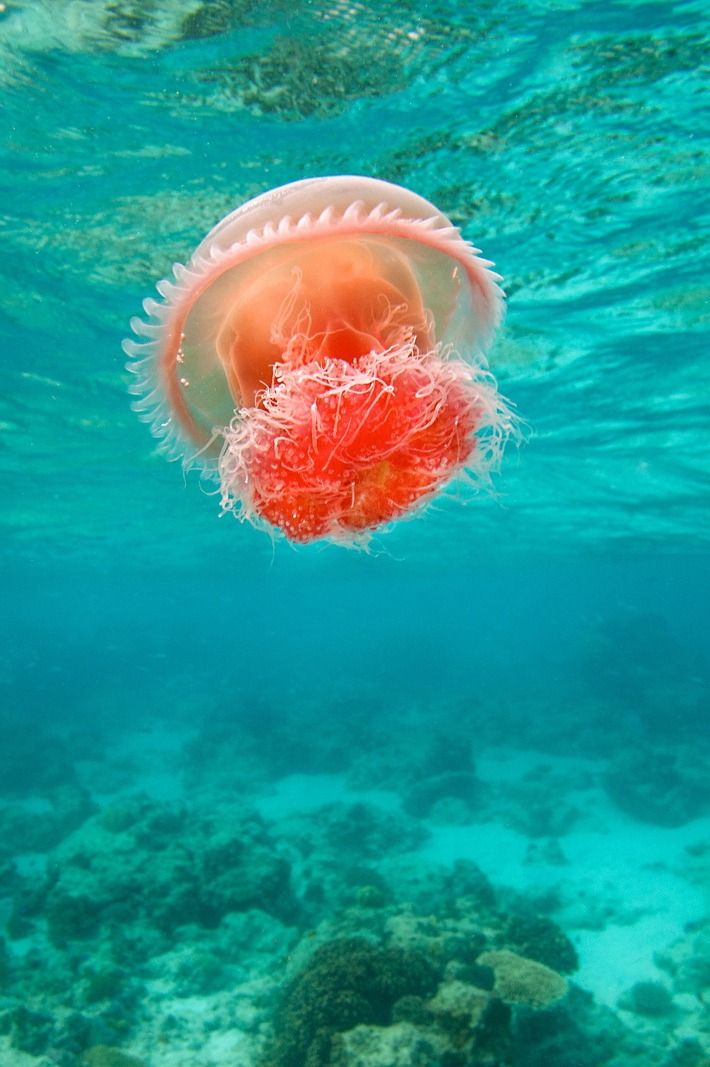
Some people who think jellyfish are fish are wrong. American public aquariums use the term "sea jelly" to refer to the jellyfish.
Japan produced the first robot jellyfish. These high-tech gadgets can not only swim beautifully and smoothly, like real jellyfish, but also “dance” to the music at the request of the owner.
Scientists call a large accumulation of jellyfish a swarm.
Jellyfish have no brain or sense organs. Their rudiments of the sense organs and the nervous system are only capable of detecting light and smell. The nerve networks possessed by jellyfish are used by them to detect the touch of another organism. These opportunities are provided by the simplest nervous system located on the epidermis of jellyfish.
Jellyfish do not have a respiratory system because their thin skin absorbs oxygen directly from the water.
Analyzing interesting facts about jellyfish, the researchers came to the conclusion that jellyfish can help a person in the fight against stress.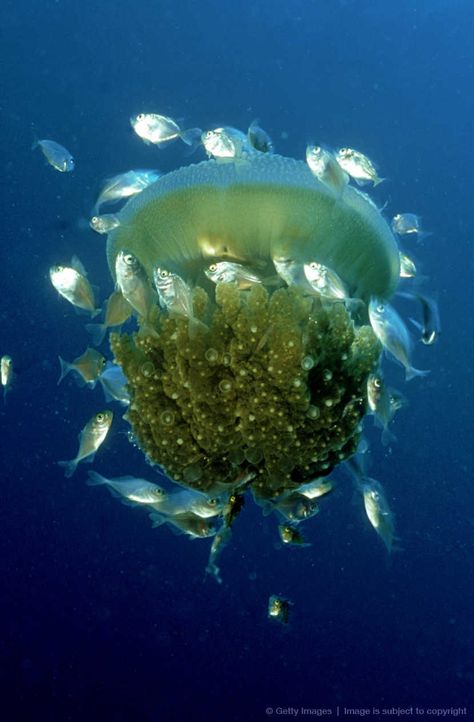 For these purposes, in Japan, they began to breed jellyfish in an aquarium, although this is not cheap, and troublesome. But this is justified - the unhurried and smooth movements of jellyfish have a calming effect on a person.
For these purposes, in Japan, they began to breed jellyfish in an aquarium, although this is not cheap, and troublesome. But this is justified - the unhurried and smooth movements of jellyfish have a calming effect on a person.
Jellyfish is more than 90 percent water. Their umbrella is a jelly (gelatinous material) called mesoglea surrounded by two layers of cells. The lower surface of the body (subumbrella) is called the bell or bell.
Dioecious jellyfish, male and female release semen and eggs into the environment to reproduce offspring. Fertilization takes place in water.
There are very dangerous jellyfish. The box jellyfish (also called the sea wasp) kills more people every year than any other marine creature. This jellyfish swims at a speed of 2 m / s, and its bite can kill in just 3 minutes.
Since 1954, more than 5.5 thousand deaths from the sting of the sea wasp have been recorded. Each of its tentacles contains about half a million glands that inject poison into the body of the victim.